December 28, 2021 - Biltmore House
|
|
We've been to Johnson City, Tennessee many times over the last seven years or so visiting my parents, but we have never toured the Biltmore Estates which is only 67 miles away. I ordered the tickets months ahead of time. I was shocked at the cost: $121 per ticket! I swallowed and clicked the [Order] button. Later on I discovered the reason the tickets were so high was because it was during the Christmas period. Normally you can get them for "only" $66 although they vary the price depending on the date. Still, I've been to a lot of attractions and this has to be the most expensive I've encountered. It must be good.
Anyways, today was the day! The Biltmore mansion is supposed to be spectacular around Christmas with all the decorations.
Here we are approaching the main gate to the Biltmore Estate.
|
| |
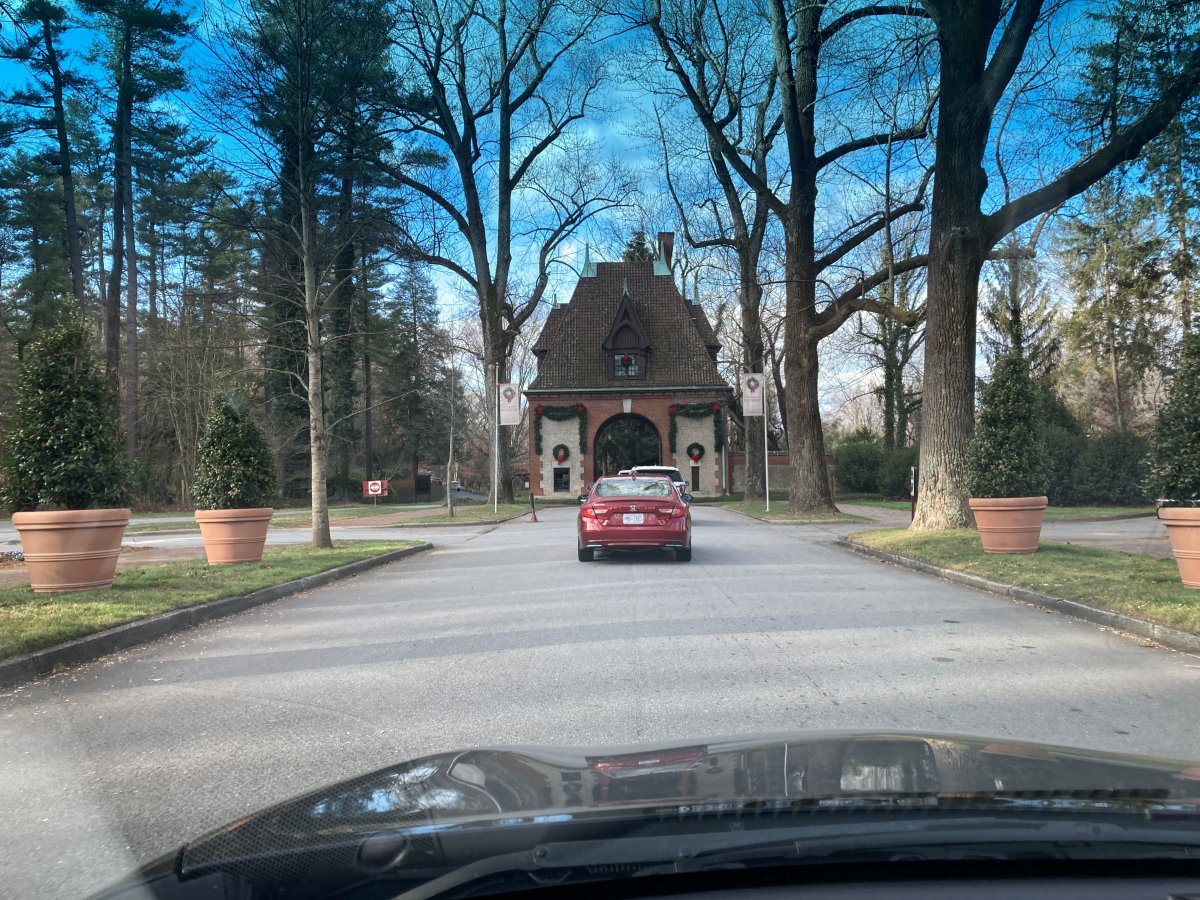 |
|
|
The estate grounds are huge and mostly undeveloped. You drive for ten minutes through the woods to get to the big Châteauesque-style mansion.
And here we are!
The Biltmore House is the largest residence ever constructed in the United States – 175,000 square feet. Biltmore House contains 250 rooms in all including: 33 bedrooms, 43 bathrooms, 3 kitchens, 2 bowling alleys, an indoor pool, and a library with 65 fireplaces to supplement the complicated heating system necessary to keep the house warm in the winter.
|
| |
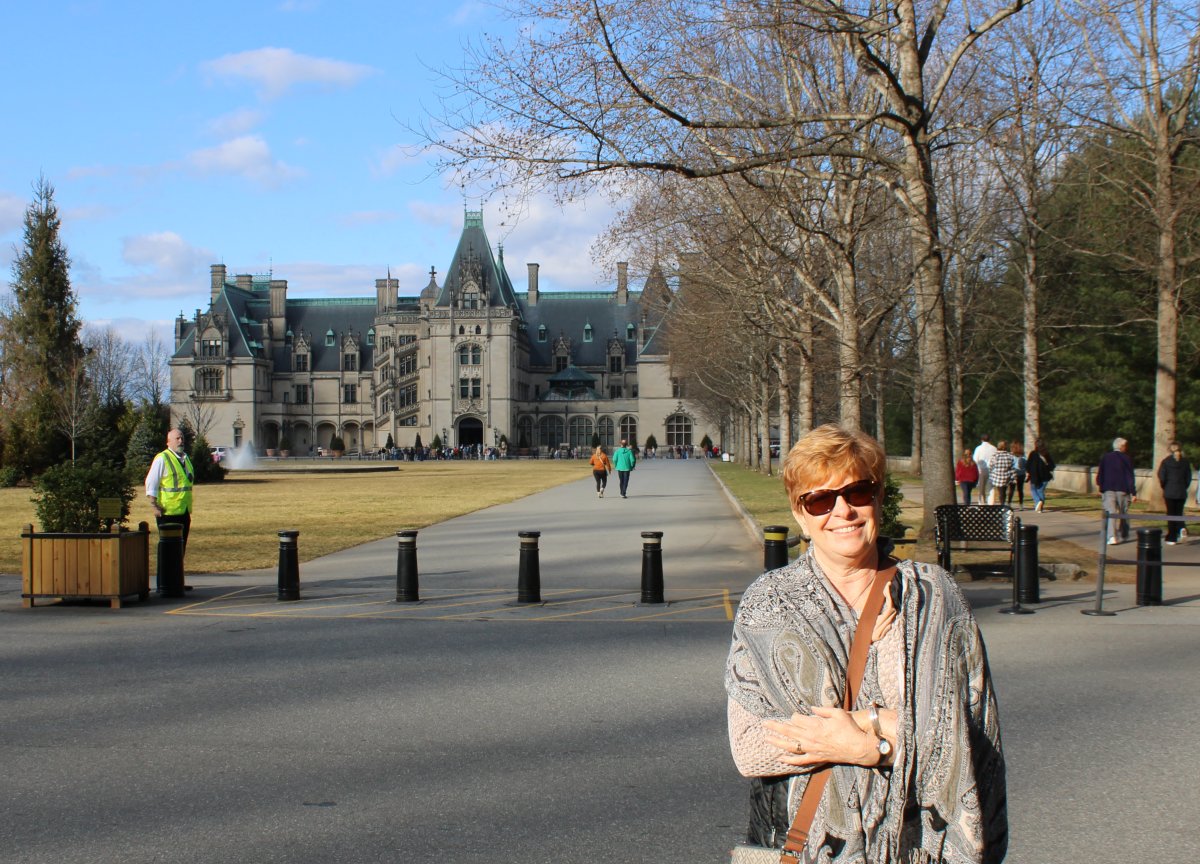 |
|
From the outside, the mansion looks like it was plucked right out of the Loire Valley in France. The outside of the Grand Staircase instantly reminded me of Chambord Chateau, which we saw back in 2016: Link.
In the 1880s, at the height of the Gilded Age, George Washington Vanderbilt II -- grandson of Cornelius Vanderbilt, founder of the family fortune -- began to make regular visits with his mother, Maria Louisa Kissam Vanderbilt, to the Asheville area. He loved the scenery and climate so much that he decided to build a summer house in the area, which he called his "little mountain escape". His older brothers and sisters had built luxurious summer houses in places such as Newport, Rhode Island, the Gold Coast of Long Island, and Hyde Park, New York.
Vanderbilt named his estate Biltmore, combining De Bilt (his ancestors' place of origin in the Netherlands) with more (mor, Anglo-Saxon for "moor", an open, rolling land). Vanderbilt bought nearly 700 parcels of land, including over 50 farms and at least five cemeteries; a portion of the estate was once the community of Shiloh. A spokesperson for the estate said in 2017 that archives show much of the land "was in very poor condition, and many of the farmers and other landowners were glad to sell."
|
| |
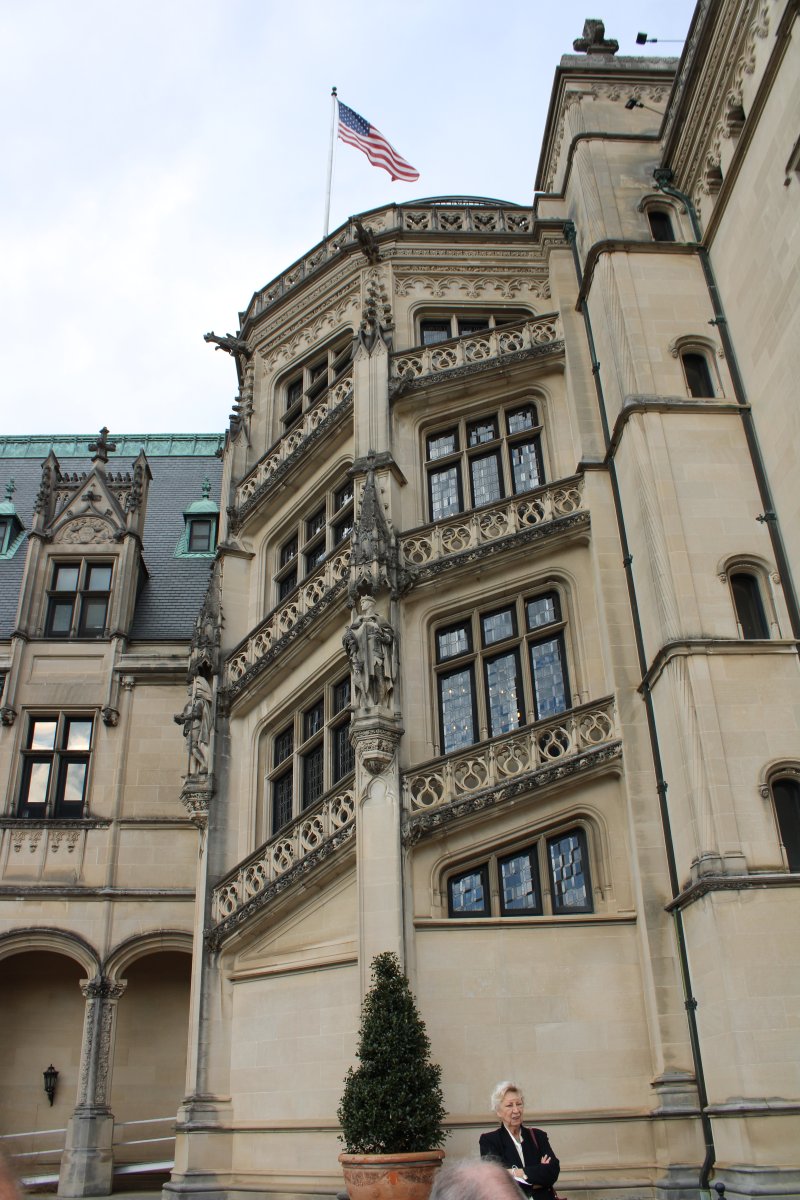 |
|
|
Construction of the house began in 1889. A three-mile railroad spur was constructed to bring materials to the building site. Construction on the main house required the labor of about 1,000 workers and 60 stonemasons. Vanderbilt made extensive trips overseas during construction to purchase decor. He returned to North Carolina with thousands of furnishings for his newly built home, including tapestries, hundreds of carpets, prints, linens, and decorative objects, dating from the 15th century to the late 19th century.
George Vanderbilt opened his opulent estate on Christmas Eve of 1895 to family and friends from across the country, who were encouraged to enjoy leisure and country pursuits. Guests to the estate over the years included novelists Edith Wharton and Henry James, ambassadors Joseph Hodges Choate and Larz Anderson, and U.S. presidents.
An impressive statue of French Saint Louis at the front of the mansion. Another of French Saint Joan of Arc it out of sight to the left.
|
| |
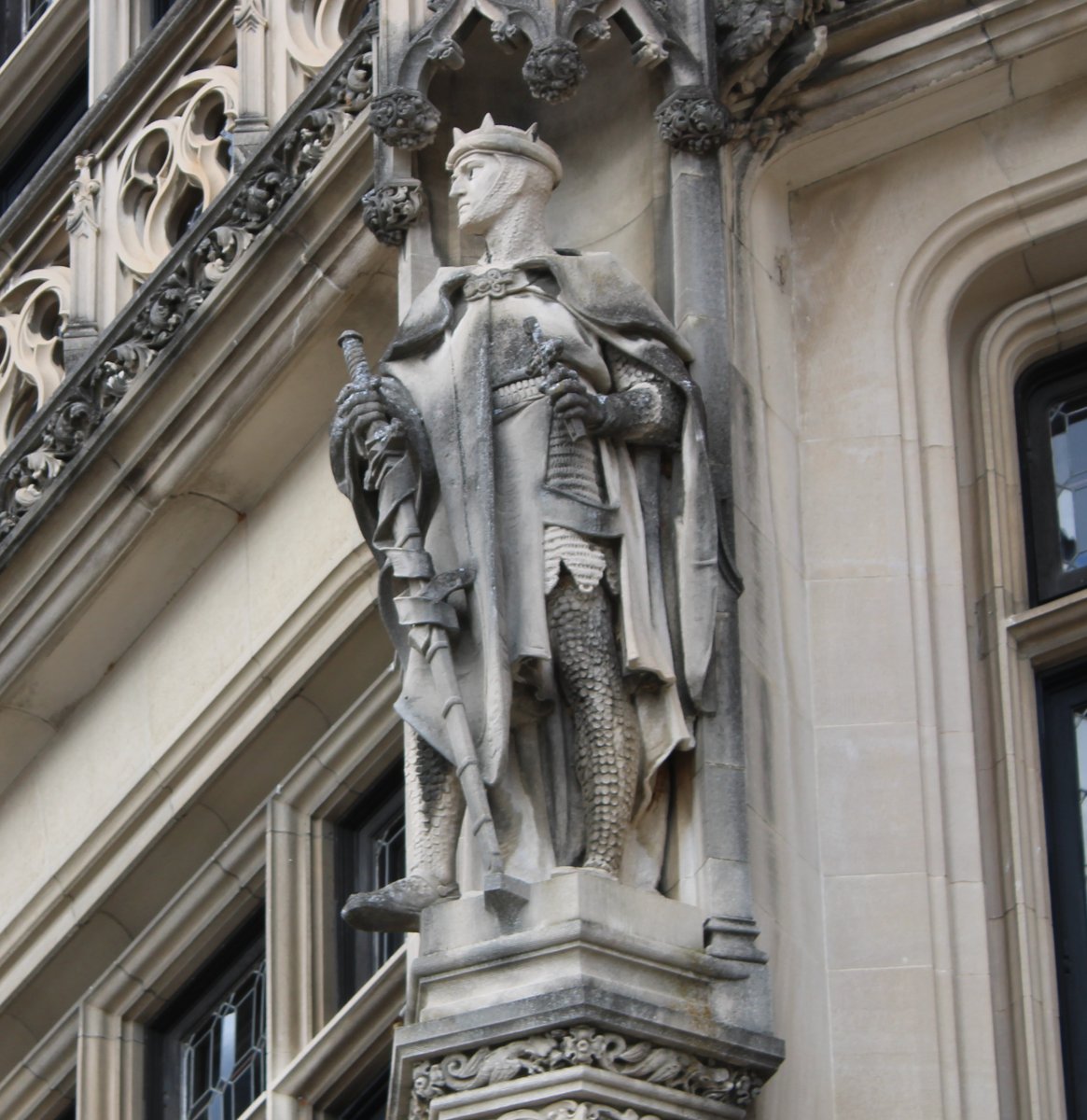 |
|
|
George married Edith Stuyvesant Dresser in 1898 in Paris, France. At age 25, Edith became the hostess of Biltmore.
Their only child, Cornelia Stuyvesant Vanderbilt, was born at Biltmore in the Louis XV room in 1900, and grew up at the estate.
Vanderbilt's died in 1914 of complications from an emergency appendectomy. He was only 51, and had only enjoyed Biltmore for 19 years. Edith intermittently occupied the house, living in an apartment created in the former Bachelors' Wing, until the marriage of her daughter Cornelia to John Francis Amherst Cecil in April 1924. The Cecils had two sons, who were born at Biltmore in the same room where their mother was born.
In an attempt to bolster the estate's finances during the Great Depression, Cornelia and her husband opened Biltmore to the public in March 1930 at the request of the City of Asheville, which hoped to revitalize the area with tourism. Since then descendents of George and Edith have worked to create a profitable and self-sustaining enterprise. The estate was designated a National Historic Landmark in 1963. The Biltmore Company is privately held.
We had a timed-entry ticket. I could understand why they have the system here. Lots of people were here to see the mansion, which could only hold so many people at a time, so the timed-entry system was very effective in keeping the right number of people in the house at any one time.
Fierce lion statues are just outside the main entrance.
|
| |
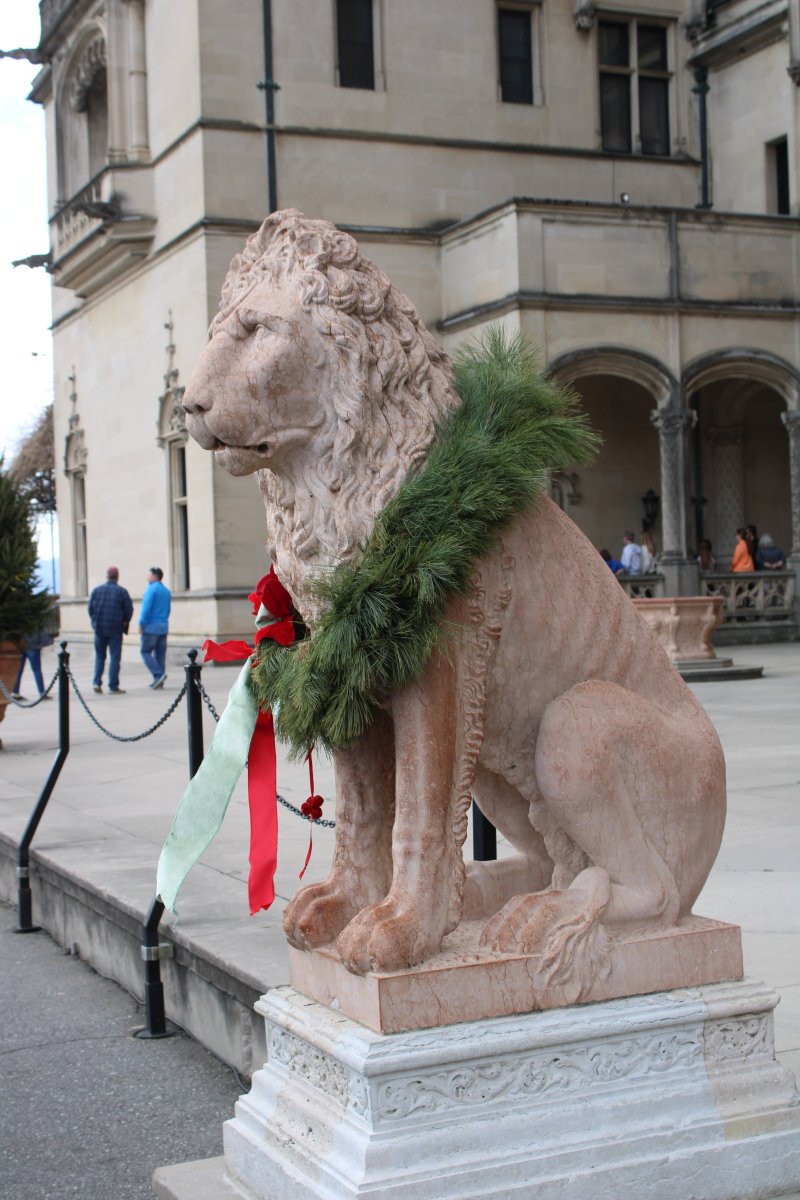 |
|
|
After entering through the marbled entrance hall, the first room we came to was the octagonal sunken Winter Garden, beautifully decorated with poinsettas.
We were on an Audio Guide tour. Each room had a number, and you just punched in the number on the device, and then listened to an excellent brief on the room.
|
| |
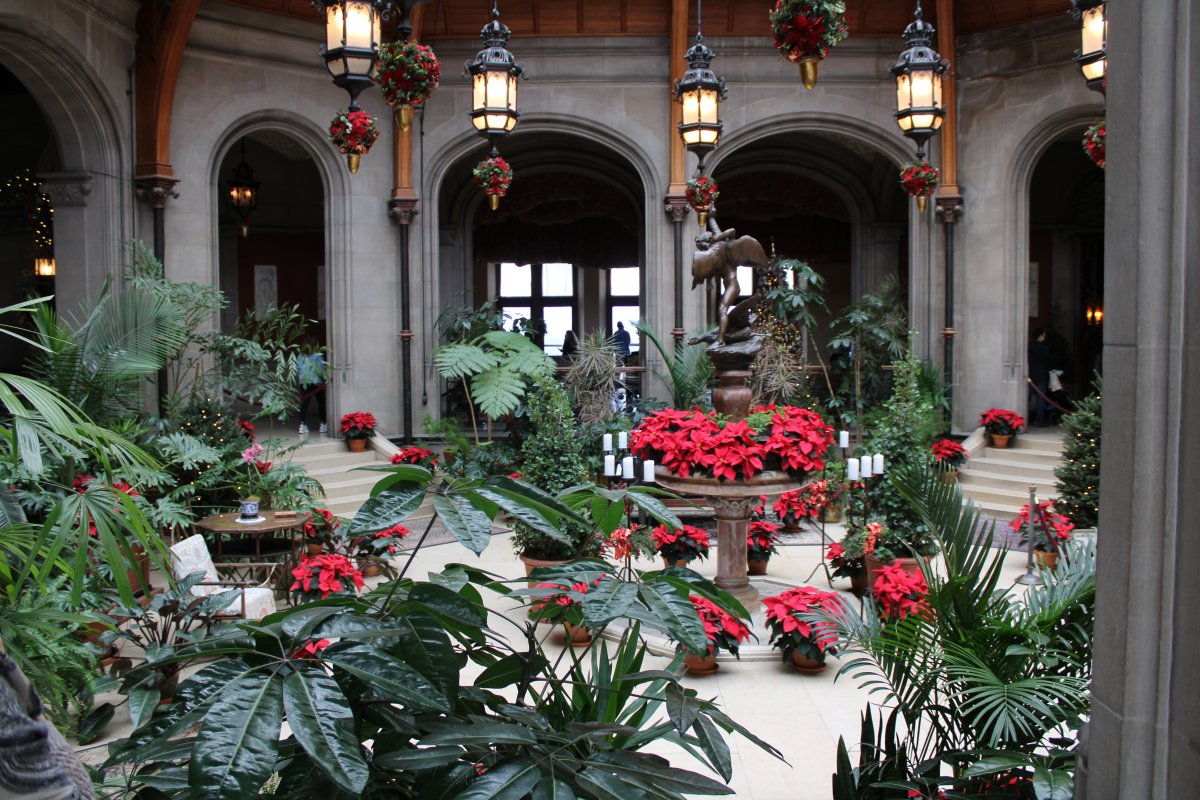 |
|
| Check out that ornate vaulted wood ceiling. |
| |
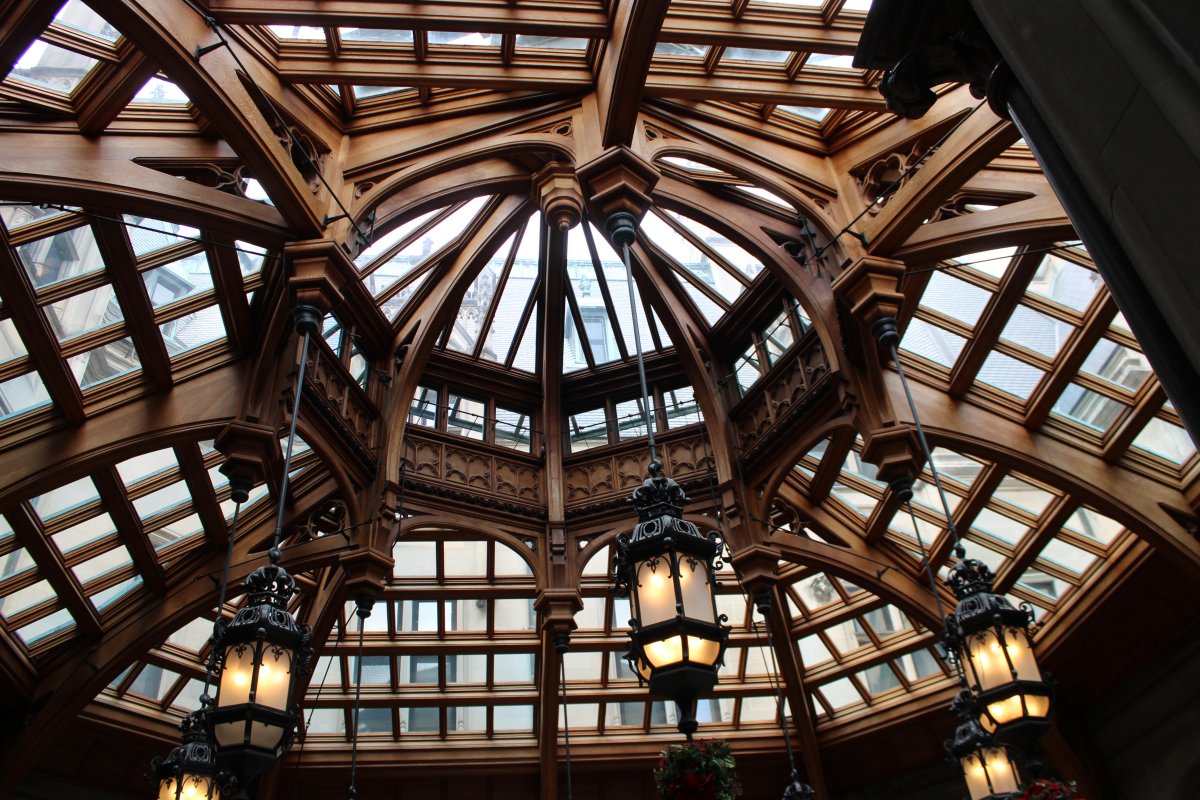 |
|
|
The centerpiece is a marble and bronze fountain sculpture titled Boy Stealing Geese.
|
| |
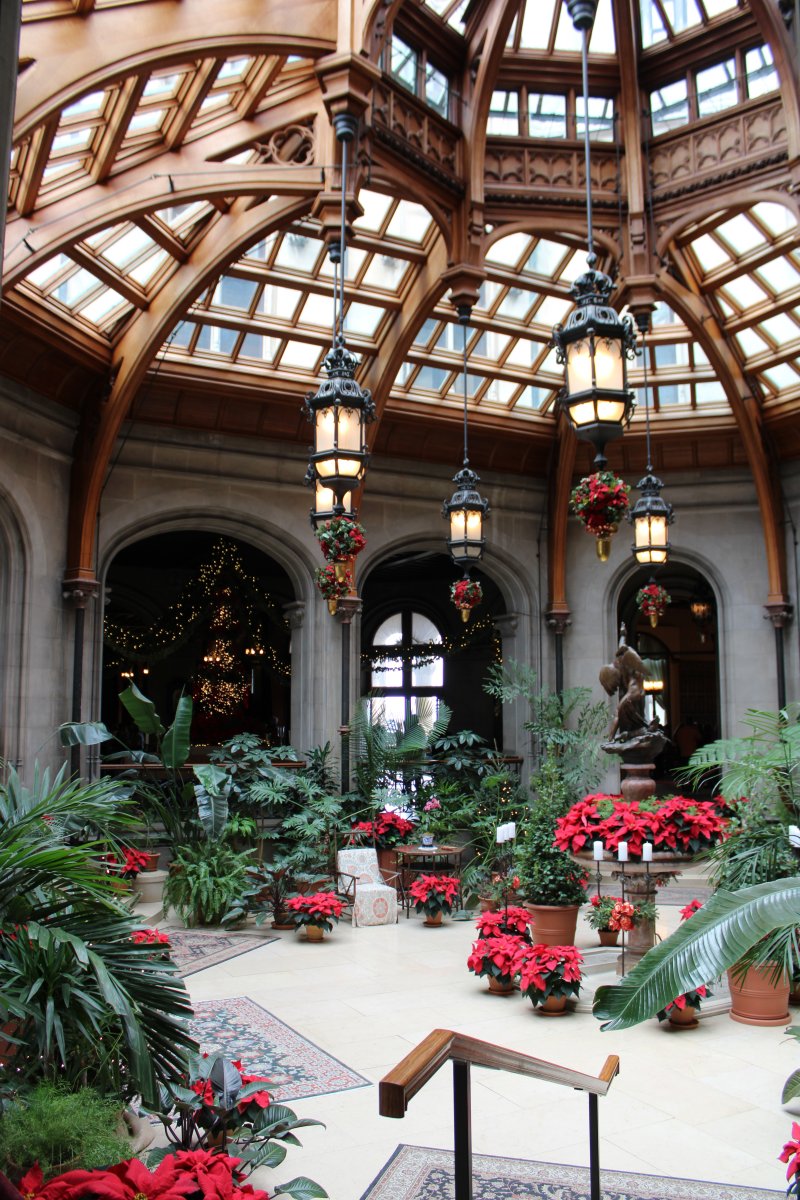 |
|
| The richly paneled Billiards Room. The custom oak billiard tables were made in 1895. |
| |
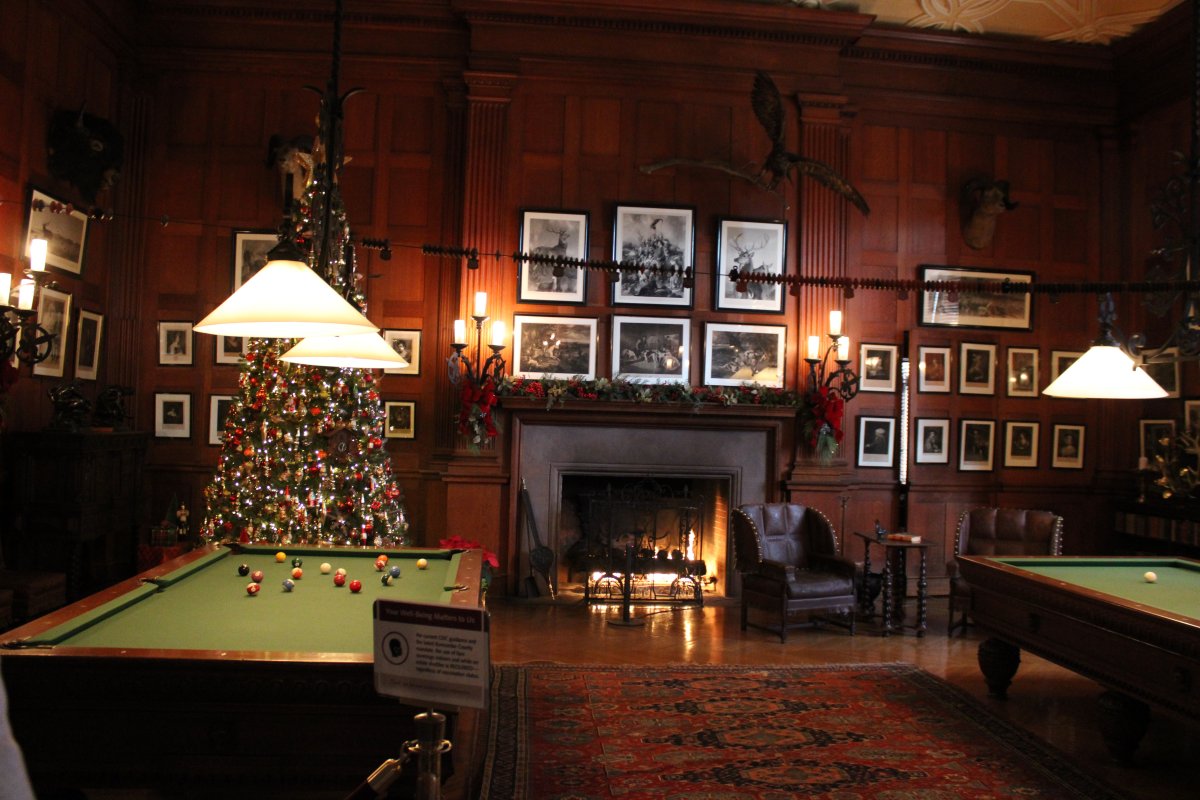 |
|
|
Each room had at least one beautifully decorated Christmas Tree and a wood fire crackling in the fireplace.
|
| |
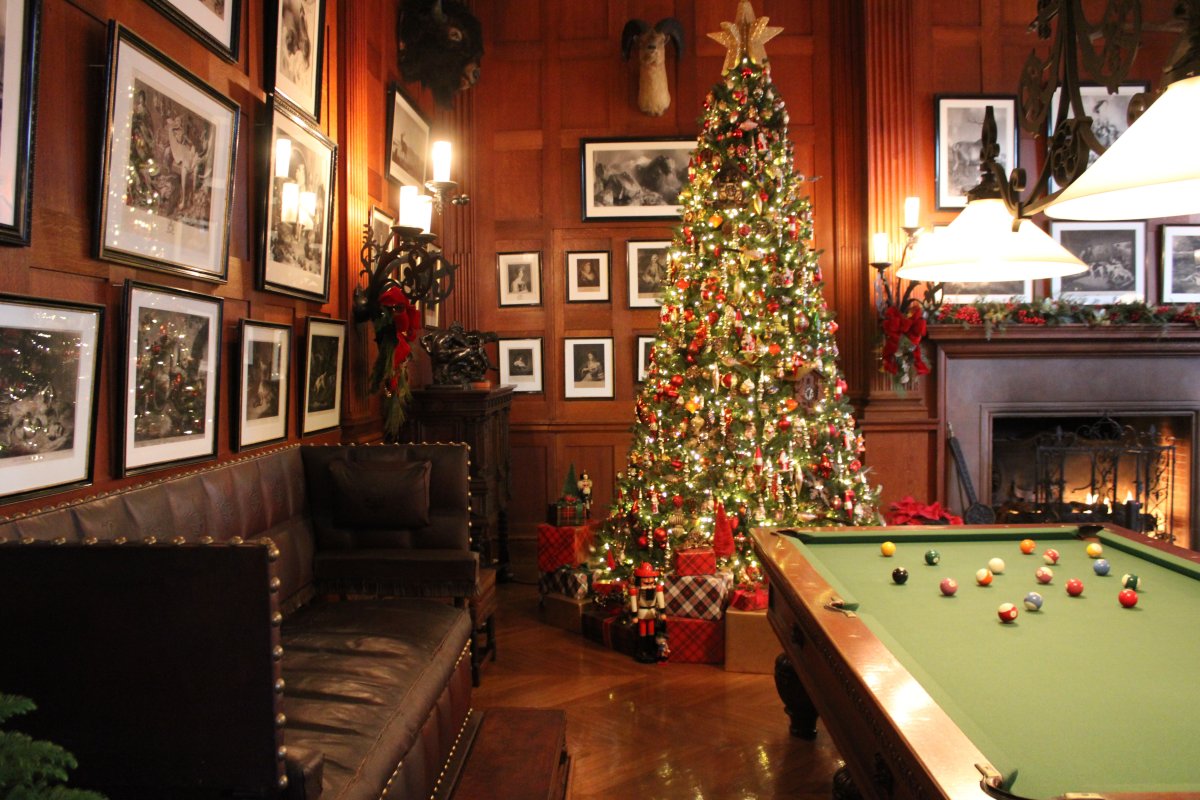 |
|
| Next stop was the Banquet Hall, largest room in the house, measuring 42 ft × 72 ft with a 70 ft-high barrel-vaulted ceiling. The table could seat 64 guests and is surrounded by rare mid-1500s Flemish tapestries and a triple fireplace that spans one end of the hall. |
| |
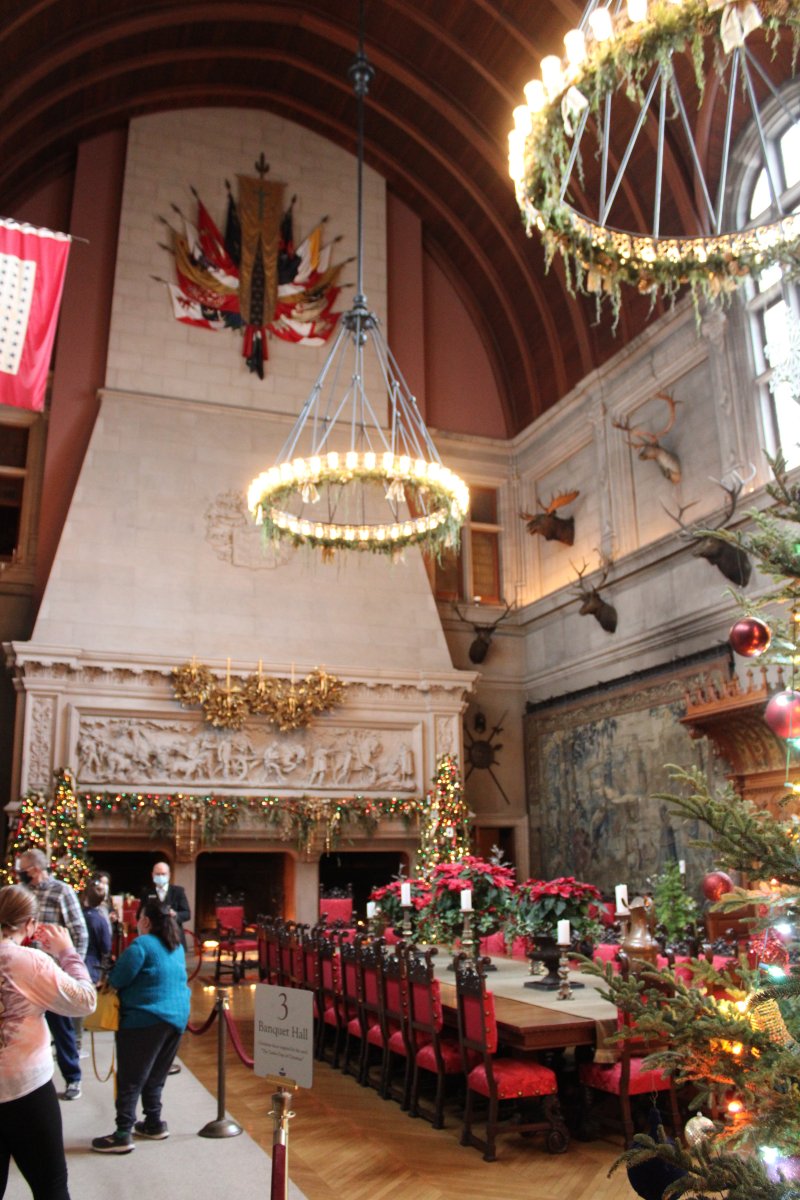 |
|
| A closer look at the large dining table. Elegant dinners took place here starting promptly at 8pm. These elaborate, ceremonious affairs featured up to 10 courses, as many as five different wine pairings and live musical entertainment. |
| |
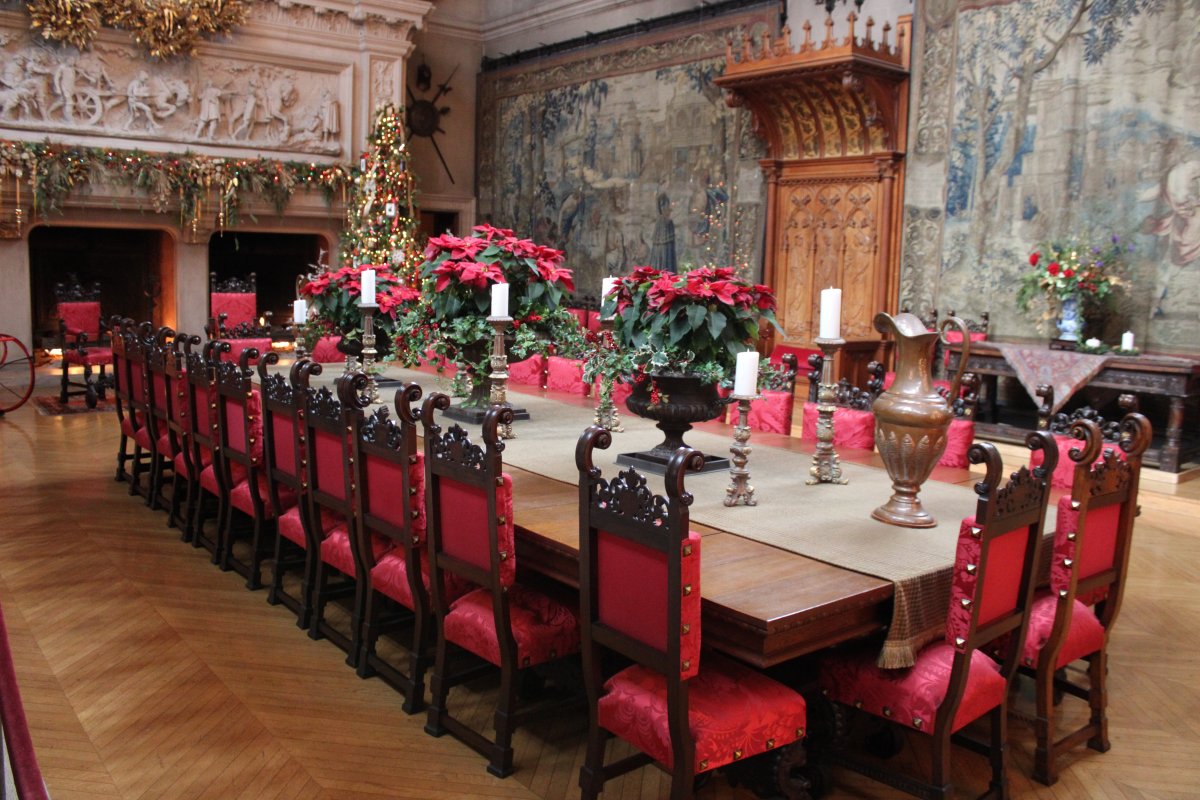 |
|
| These Flemish tapestries were made in the mid-1500s, by hand, of course. |
| |
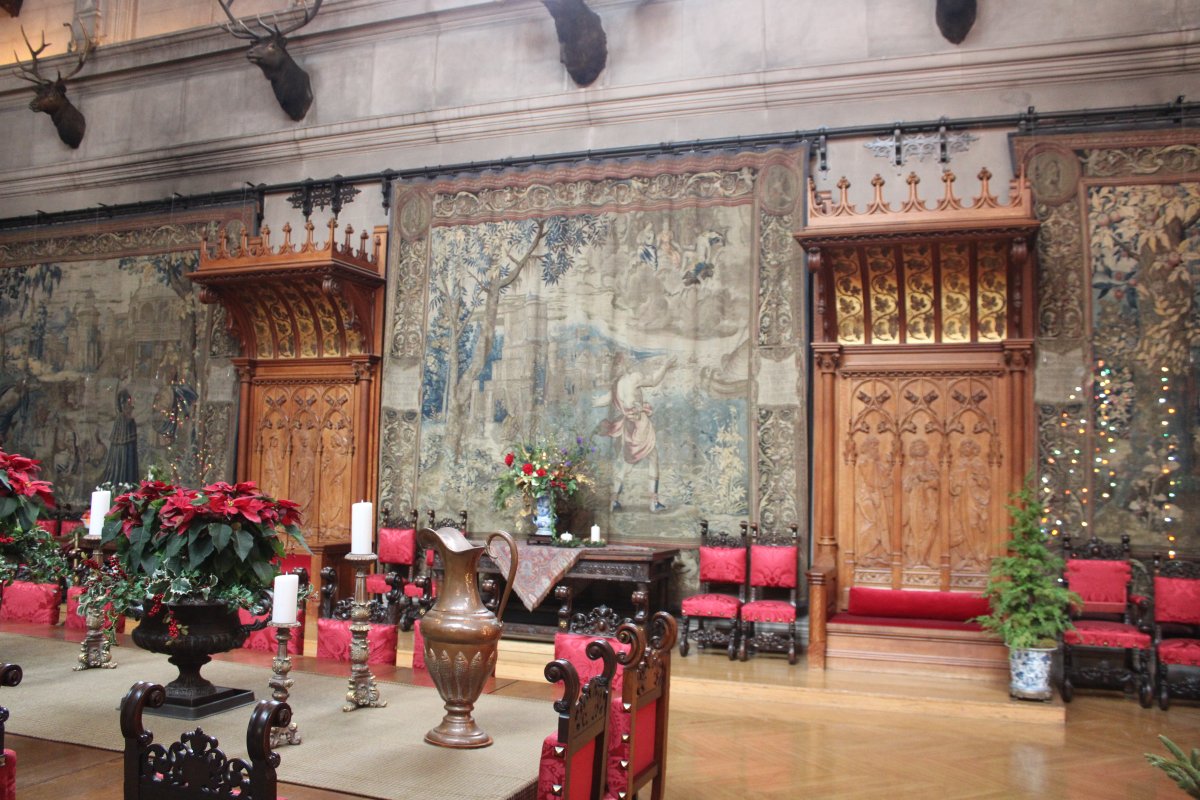 |
|
|
On the opposite end of the Banquet Hall is an organ gallery that houses a 1916 Skinner pipe organ.
|
| |
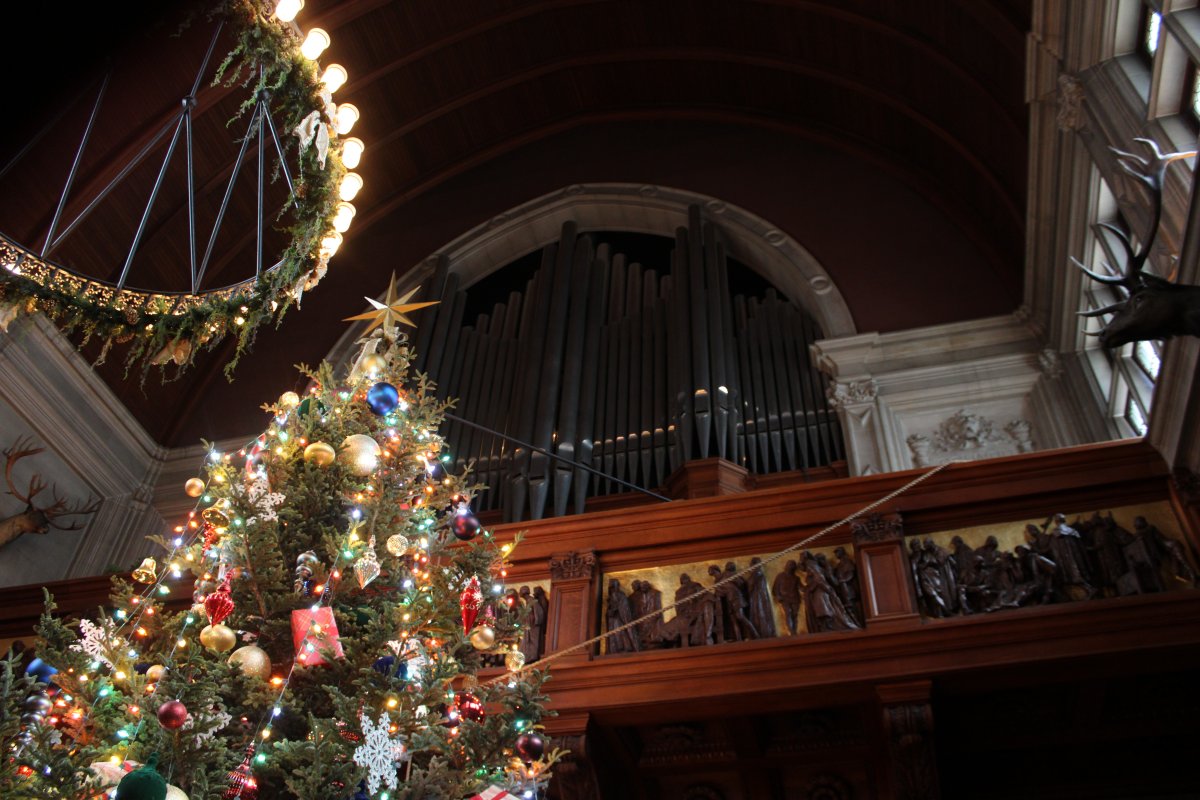 |
|
| That's one big Christmas Tree. |
| |
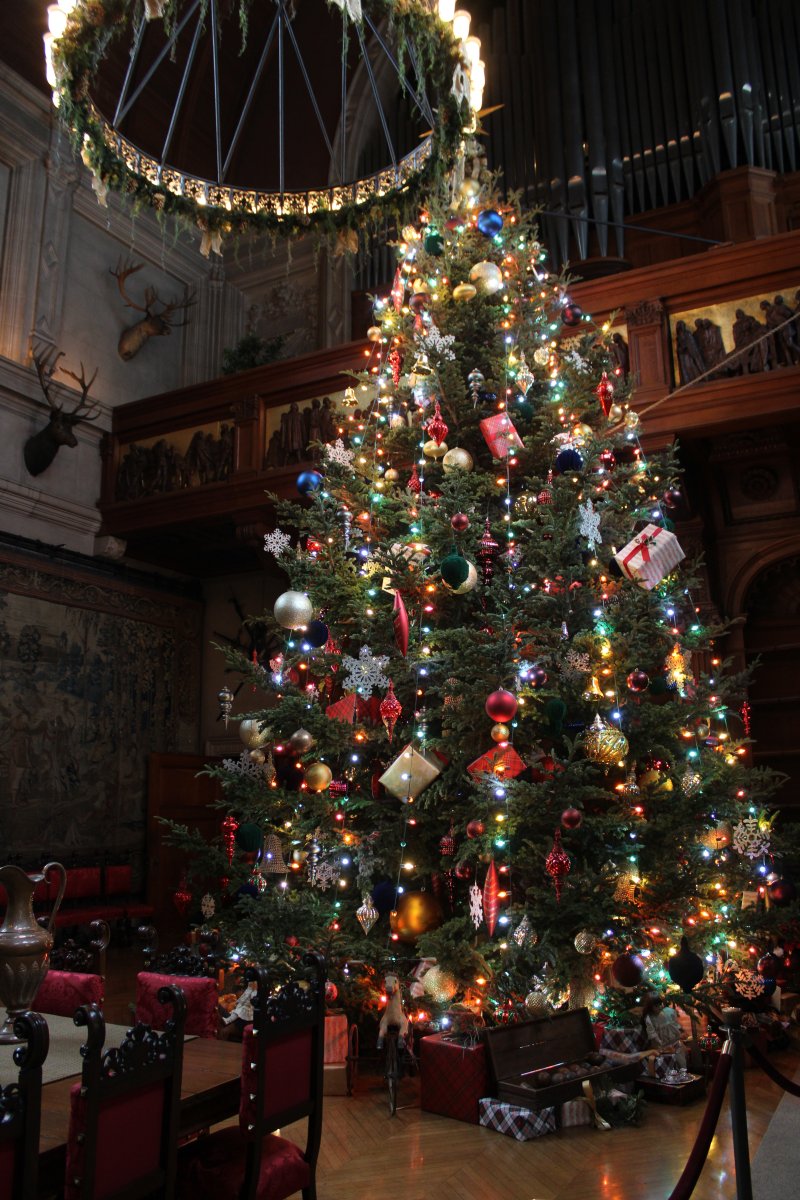 |
|
|
Hunting was always a favorite pasttime of the kings and the rich.
|
| |
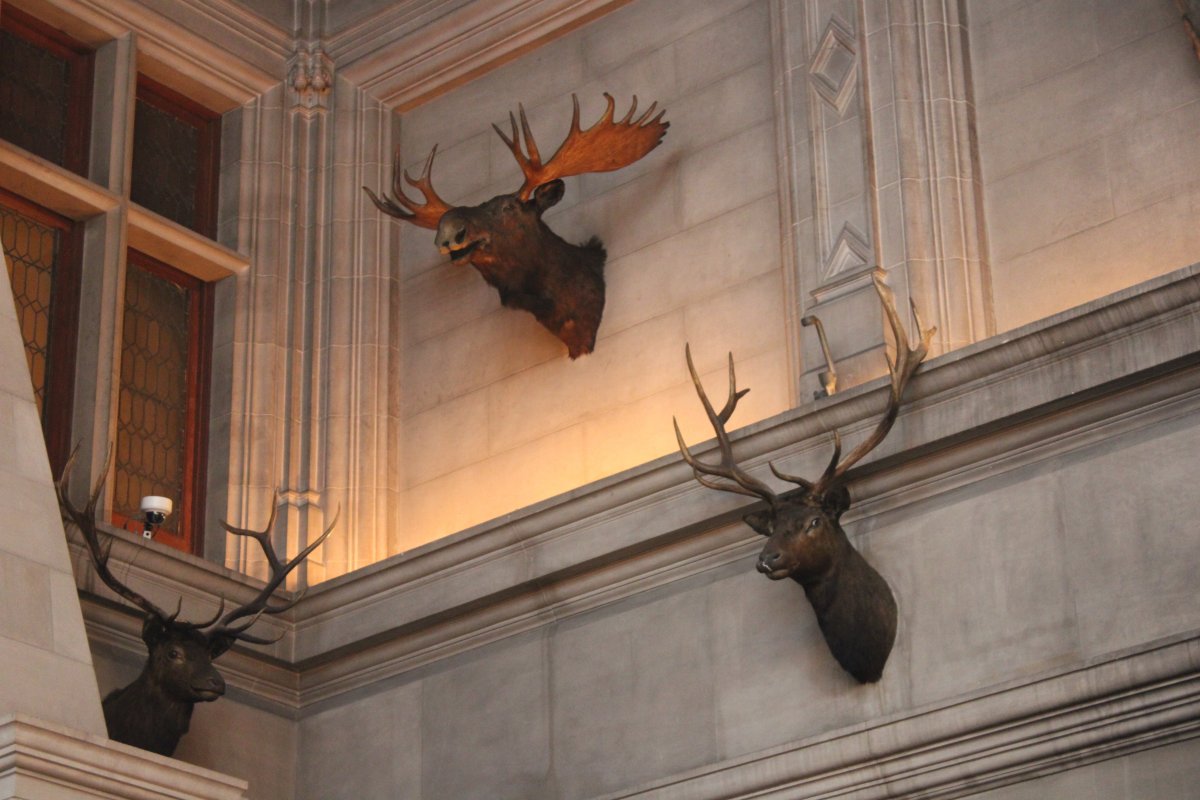 |
|
| The triple fireplace. |
| |
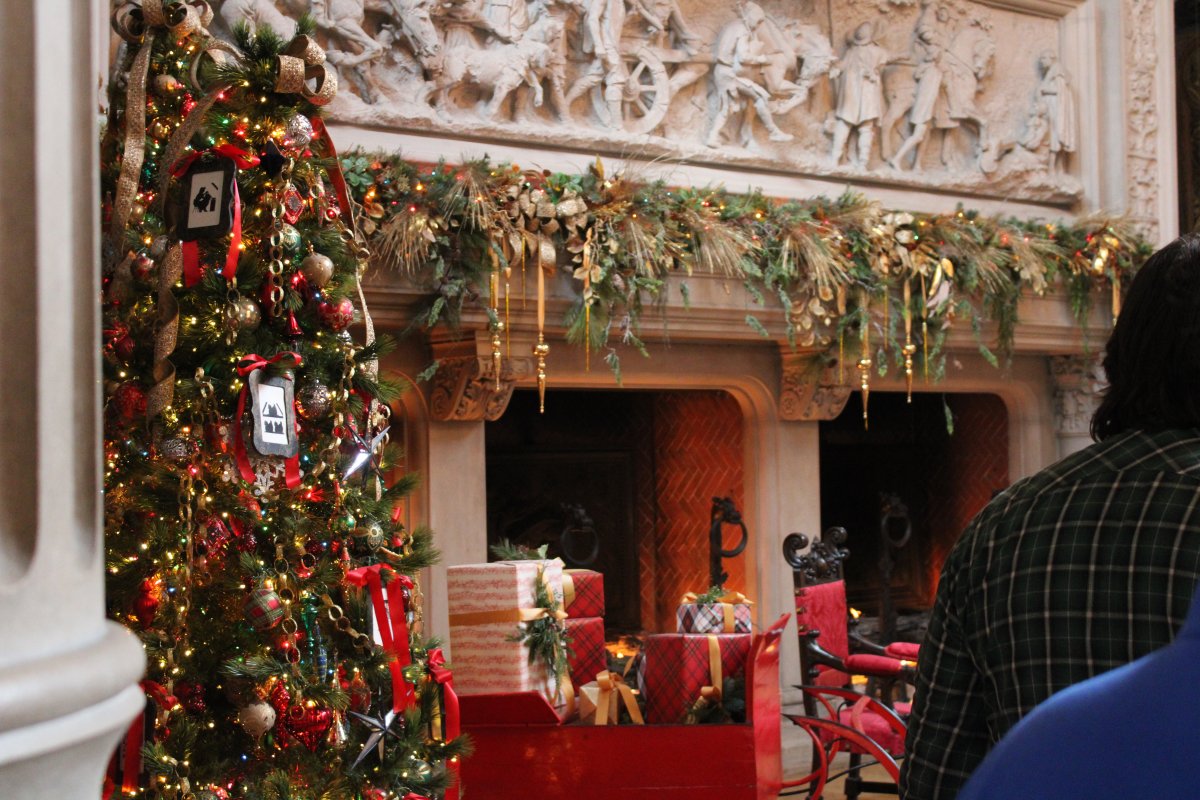 |
|
|
Another shot from a different vantage point.
|
| |
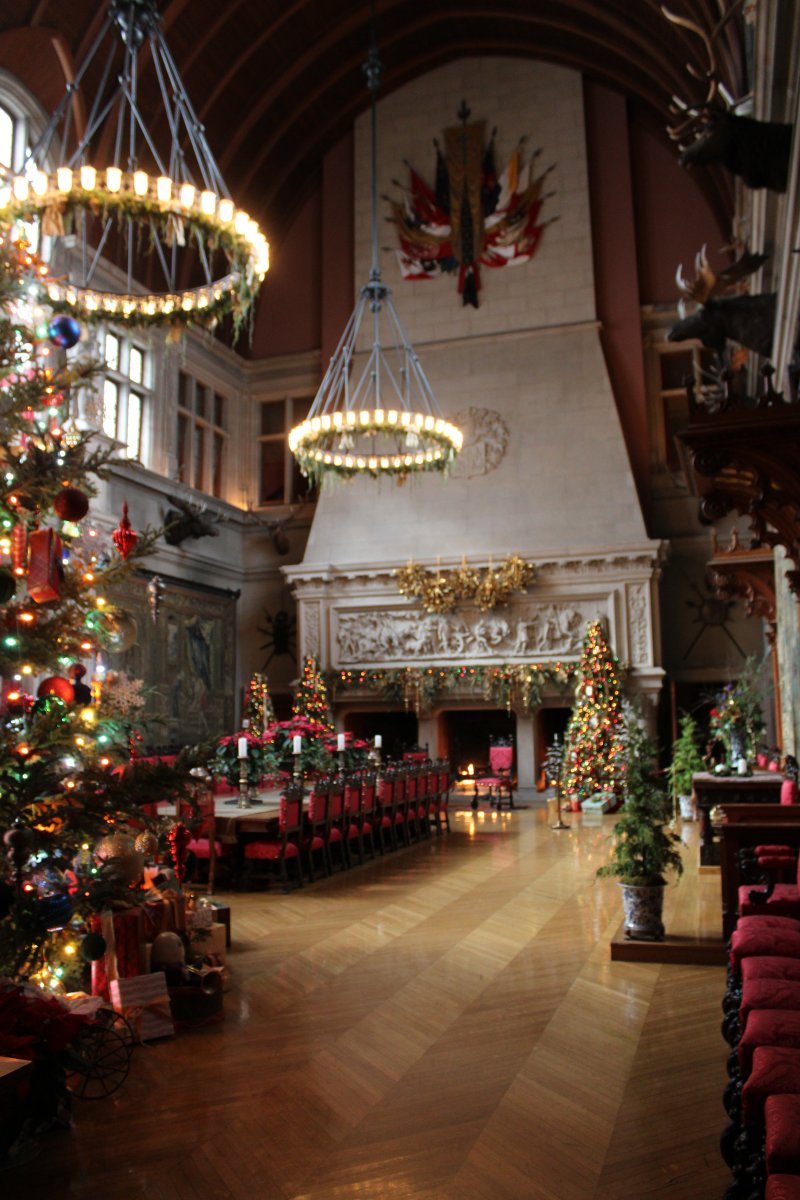 |
|
|
This is the Breakfast Room, where guests of the Vanderbilts were served breakfast and lunch.
|
| |
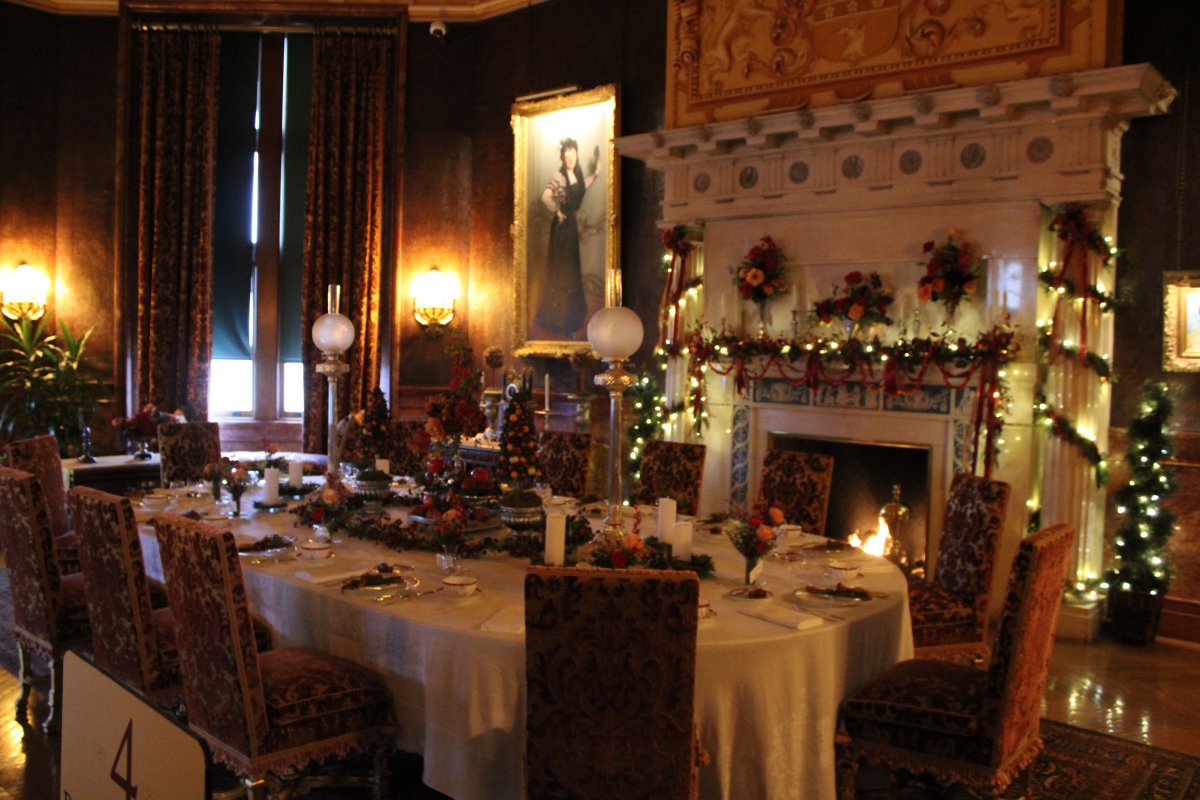 |
|
|
The elaborate ceiling of the Breakfast Room.
|
| |
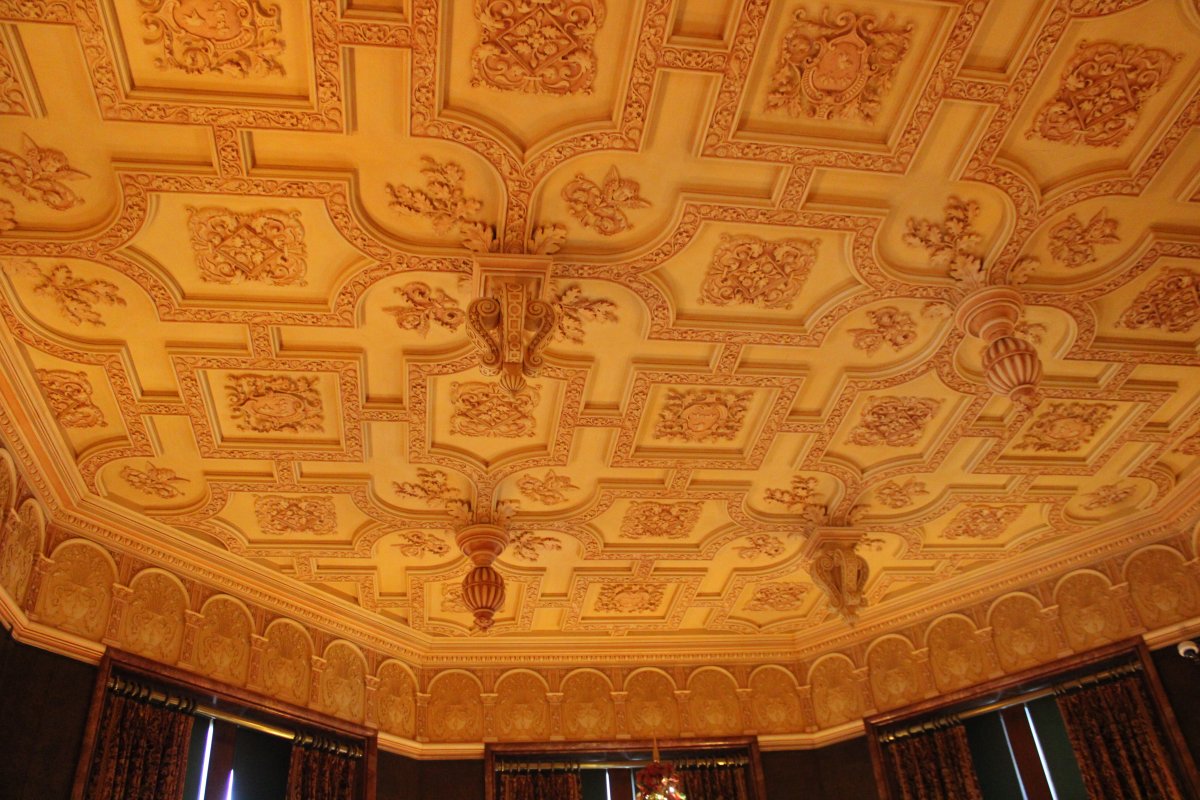 |
|
| The Breakfast Room Christmas Tree. |
| |
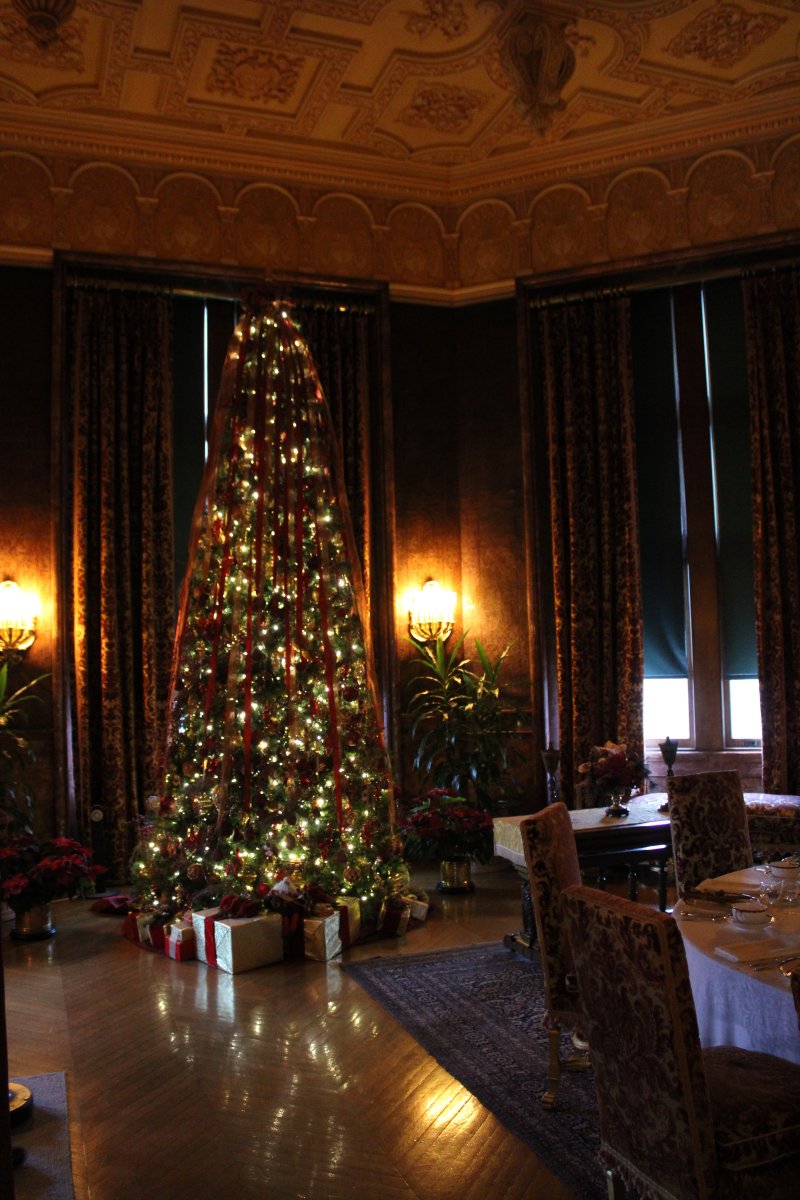 |
|
| Close-up of the Breakfast Room table with two Renoirs hanging at right. |
| |
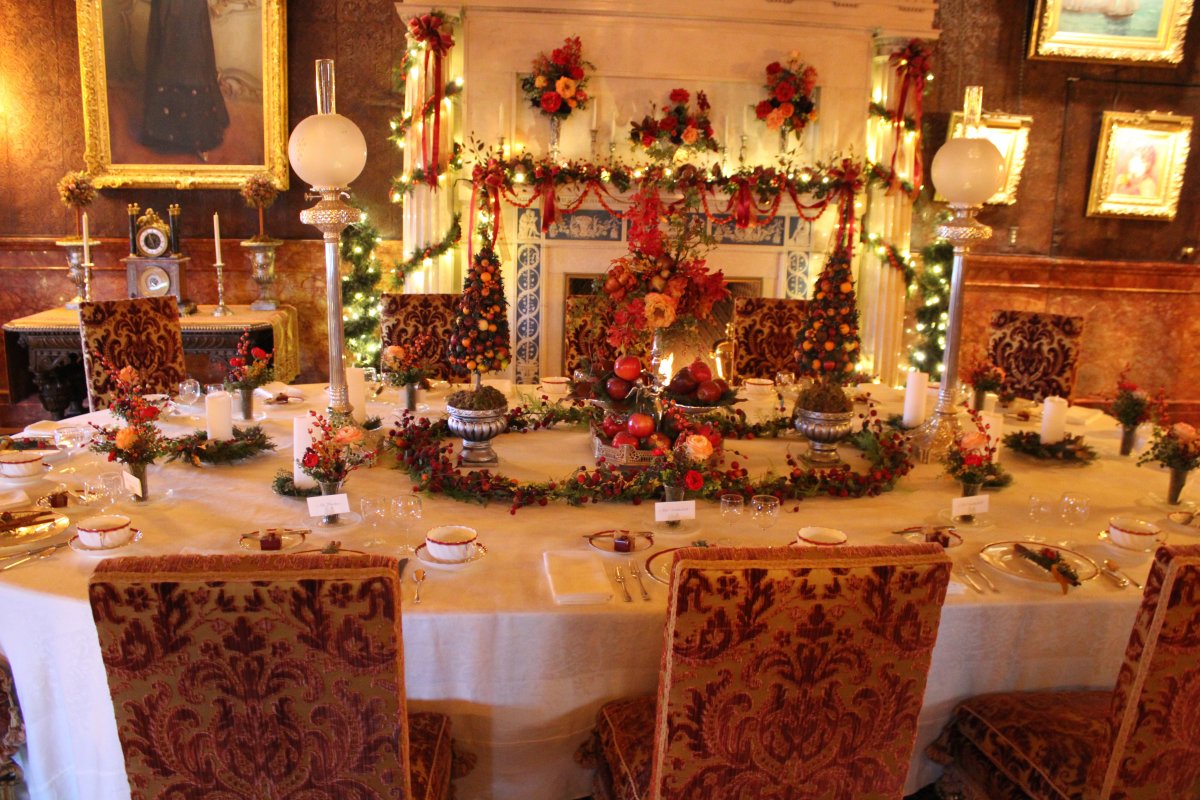 |
|
Overlooking the Dining Room is the great man himself: Cornelius Vanderbilt, founder of the family fortune. A shipping and railroad tycoon, the "Commodore" is generally considered in the top ten of richest people in history, along with oil tycoon John D. Rockfeller and steel tycoon Andrew Carnegie. He died at age 82 in 1877. His grandson, George W. Vanderbilt II, was the man who had Biltmore built and who lived here. |
| |
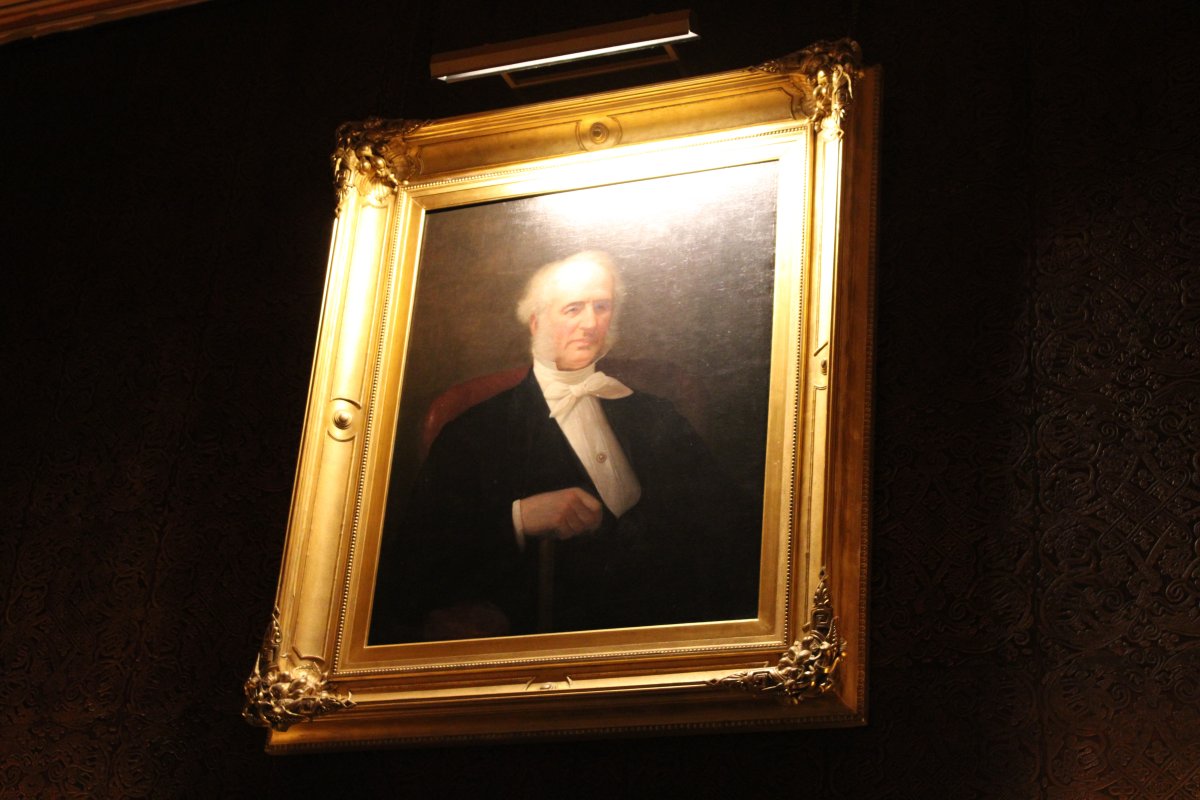 |
|
| The Salon on the other side of the Winter Garden. |
| |
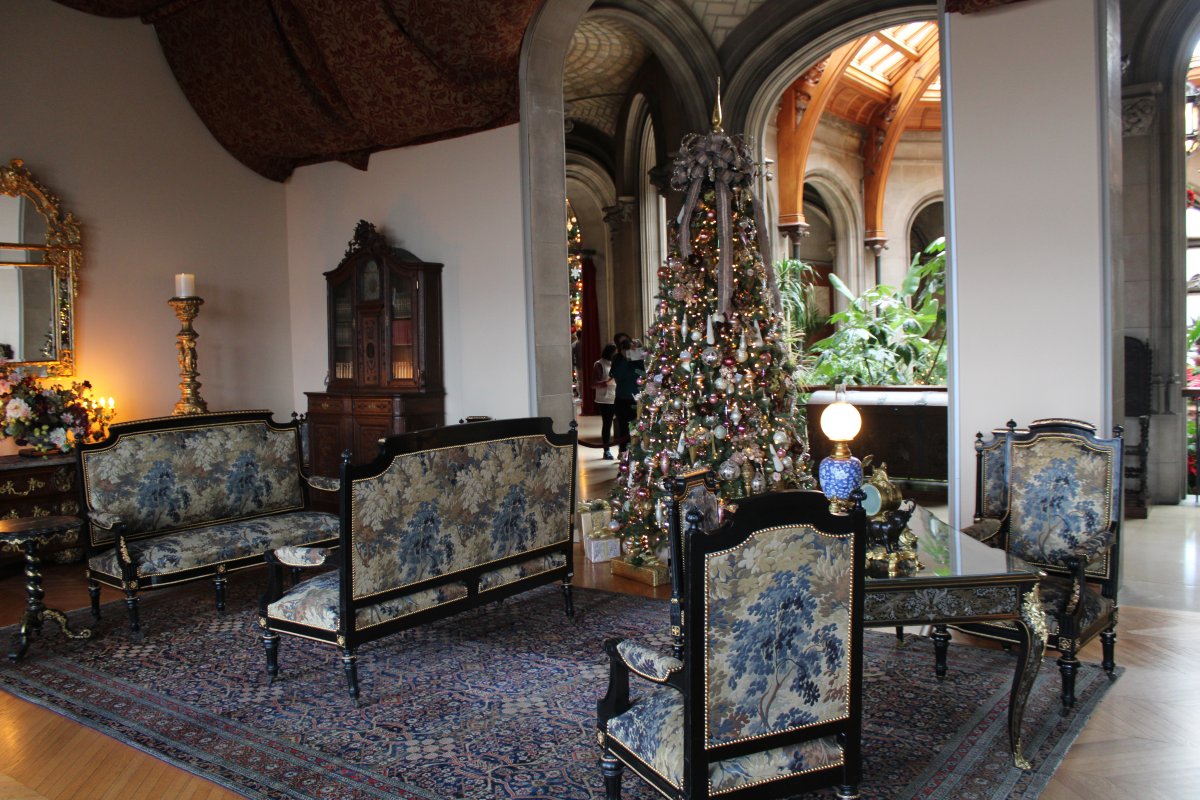 |
|
|
The view out of the back of the mansion, called Deer Park. The Blue Ridge Mountains are in the background. The estate originally consisted of an amazing 125,000 acres. Stressed by Congressional passage of income tax and the expensive maintenance of the estate, Vanderbilt initiated the sale of 87,000 acres to the federal government; his widow Edith completed the sale in 1914. She carried out her late husband's wish that the land remain pristine, and that property became the nucleus of the Pisgah National Forest.
8,000 acres now make up the Biltmore Estate.
|
| |
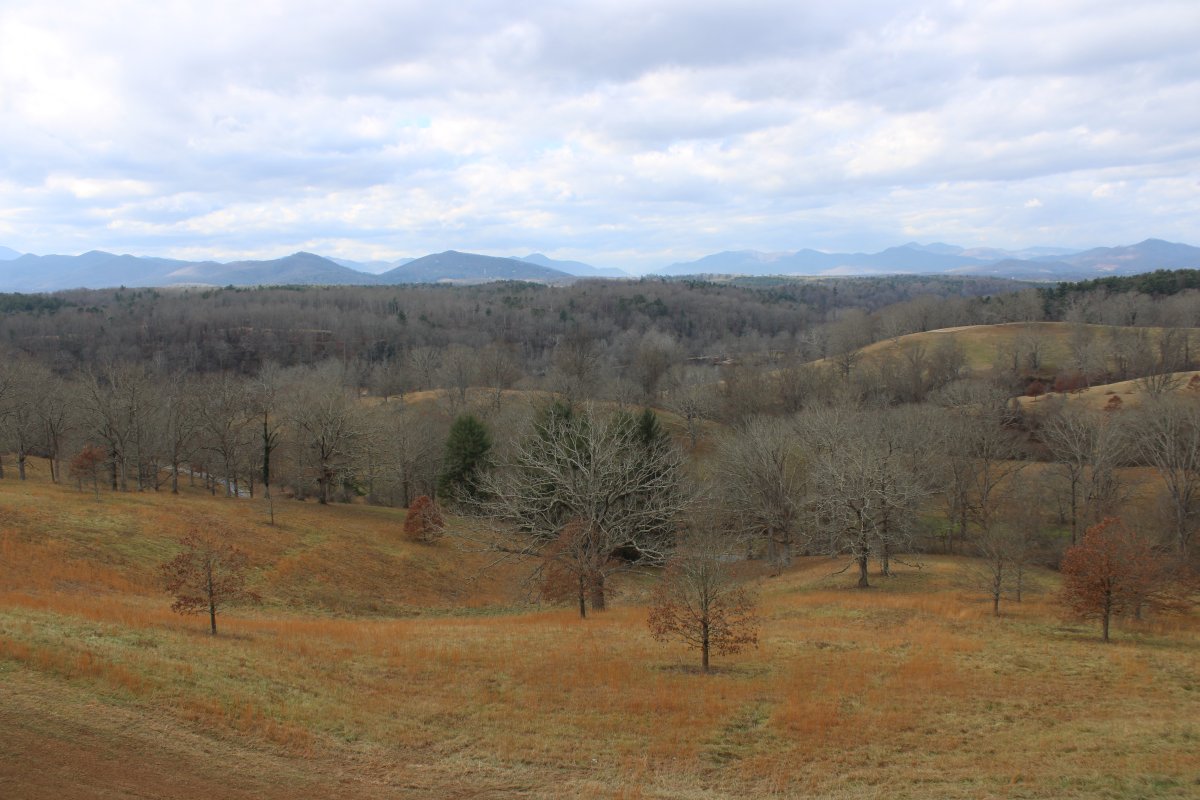 |
|
|
The Music Room, pictured below, was not finished until 1976. Prior to that it was used for storage. During World War II, the National Gallery of Art stored 62 paintings and 17 sculptures in the Music Room to protect them in the event of an attack on the United States. Among the works stored were the Gilbert Stuart portrait of George Washington and works by Rembrandt, Raphael, and Anthony van Dyck.
|
| |
 |
|
|
Left unfinished with bare brick walls, the Music Room was not completed and opened to the public until 1976. It showcases a mantel designed by Hunt, and above it a print of the large engraving by Albrecht Dürer called the Triumphal Arch, commissioned by Holy Roman Emperor Maximilian I. The mantel had been stored in the stable for over 80 years. To the right of the fireplace is a rare collection of 12 Meissen porcelain apostle figures and 12 canclesticks.
|
| |
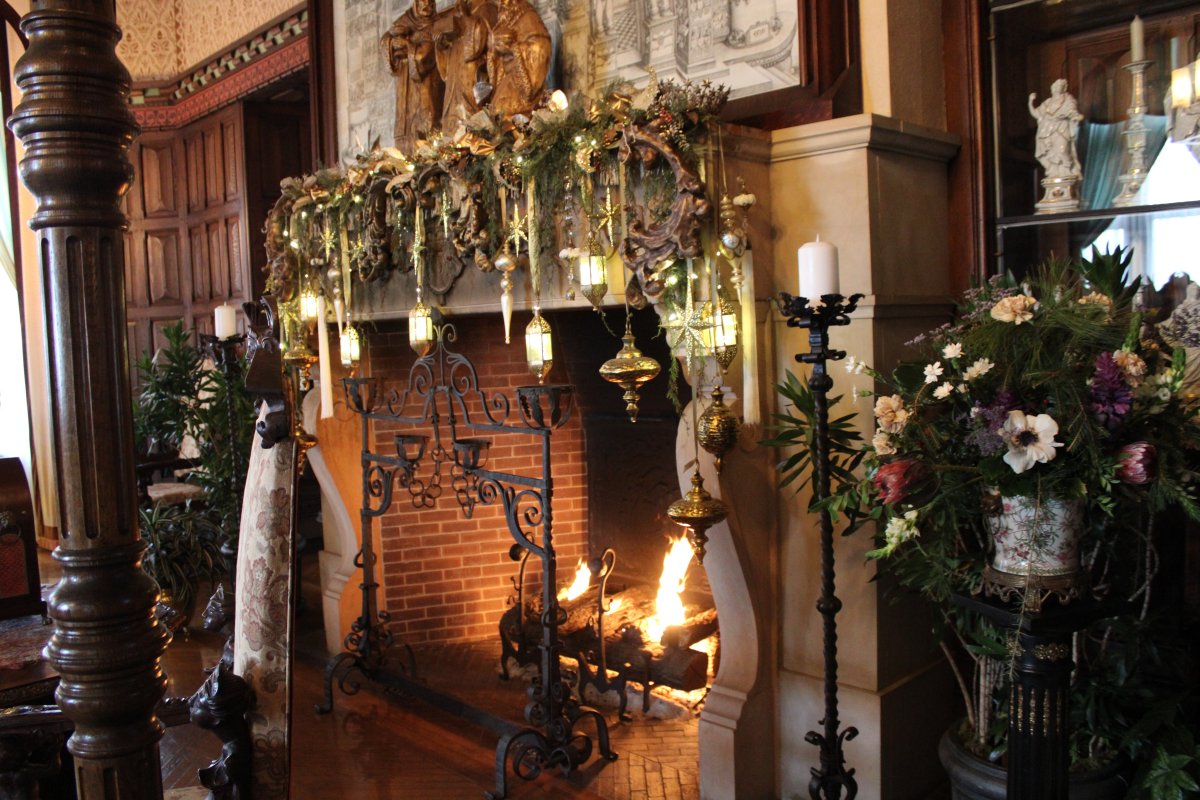 |
|
|
A better picture of the Albrecht Durer's large print above the mantel: The Triumphal Arch of Maximilian. (Photo from "A Scholarly Skater").
|
| |
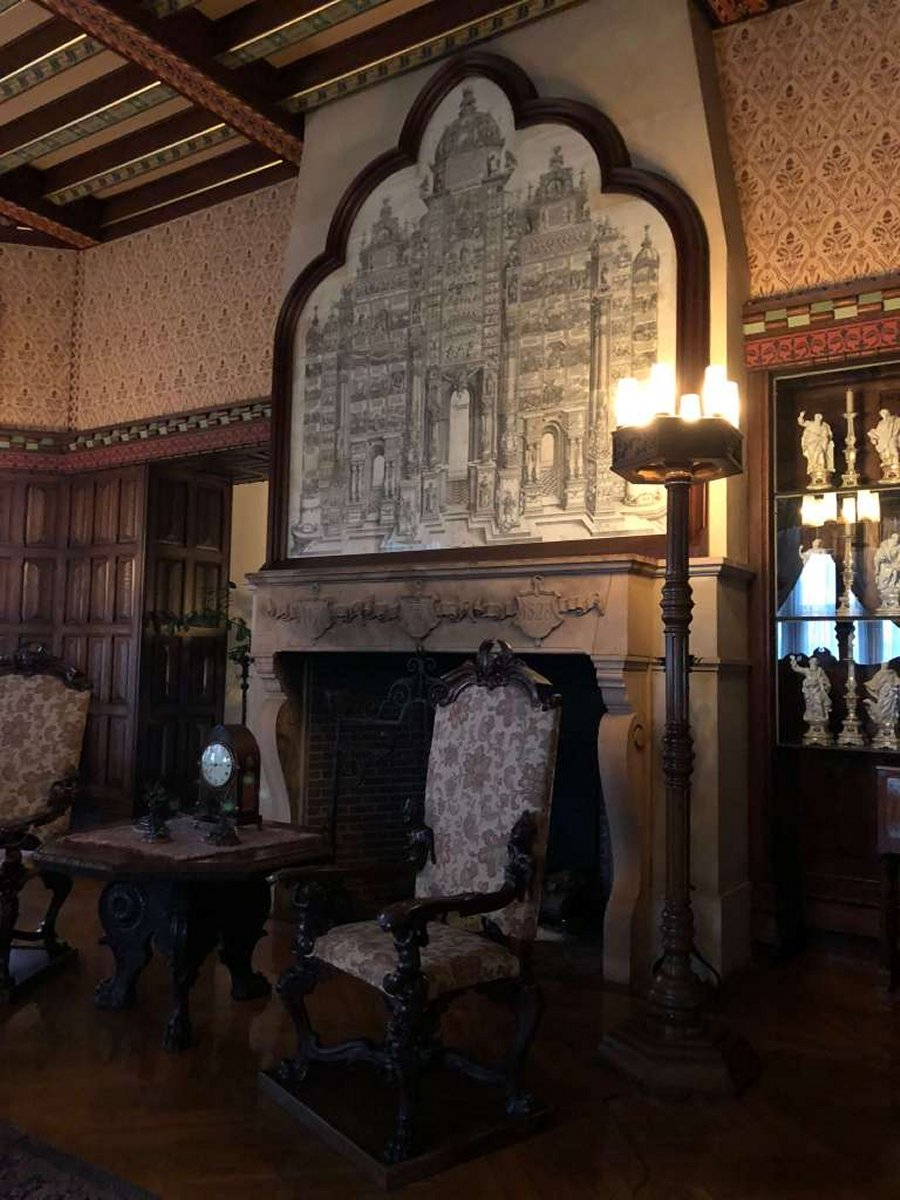 |
|
| The Music Room's elaborate ceiling. |
| |
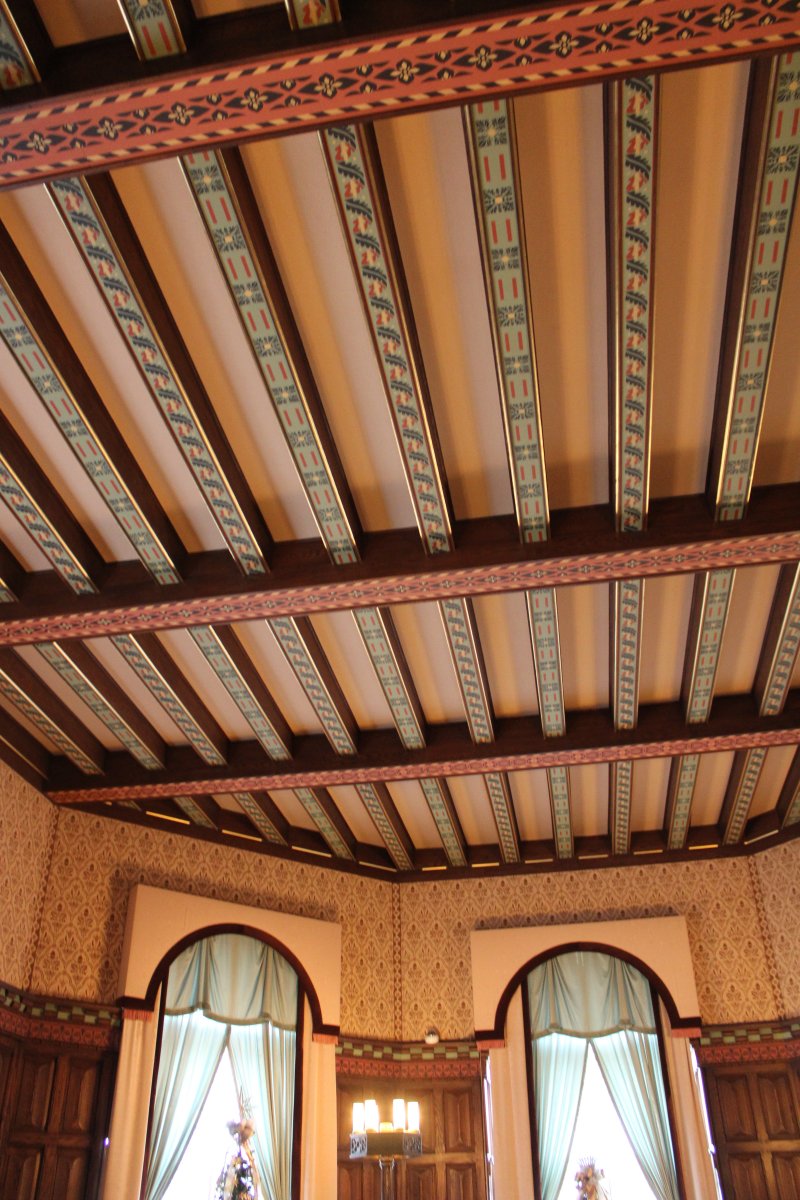 |
|
|
To the left of the entrance hall is the 90 ft-long Tapestry Gallery, which leads to the Library.
The Tapestry Gallery features three massive 16th-century Flemish tapestries representing Charity, Faith, and Prudence. Elsewhere on the walls are family portraits by John Singer Sargent, Giovanni Boldini, and James Whistler.
Unlike his father, George Vanderbilt wasn’t a big art collector. He collected prints, but beyond that, he generally preferred to spend his money on his home and lands rather than paintings and sculptures. However, he still managed to acquire quite a few notable works of art that are now on display at Biltmore. Italian artist Giovanni Boldini’s portrait of Edith Vanderbilt enjoys a prominent place in the Tapestry Gallery.
|
| |
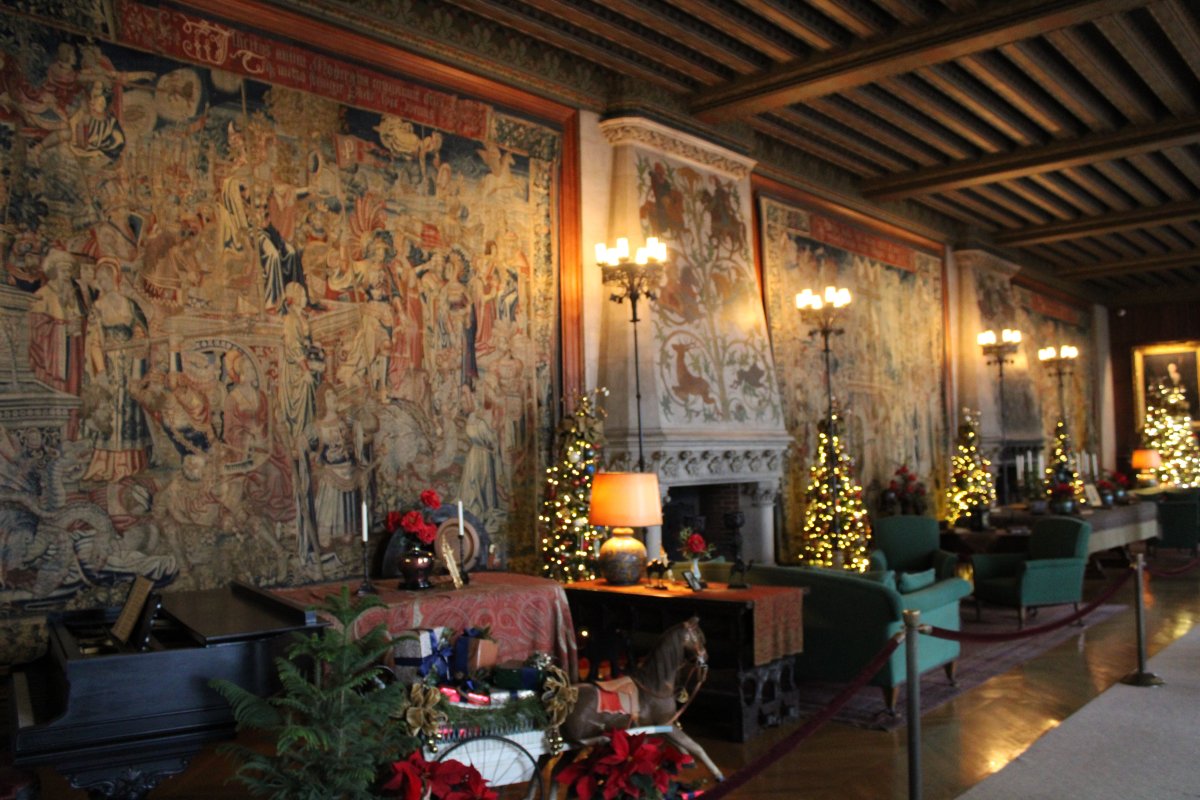 |
|
| Nice fireplace! |
| |
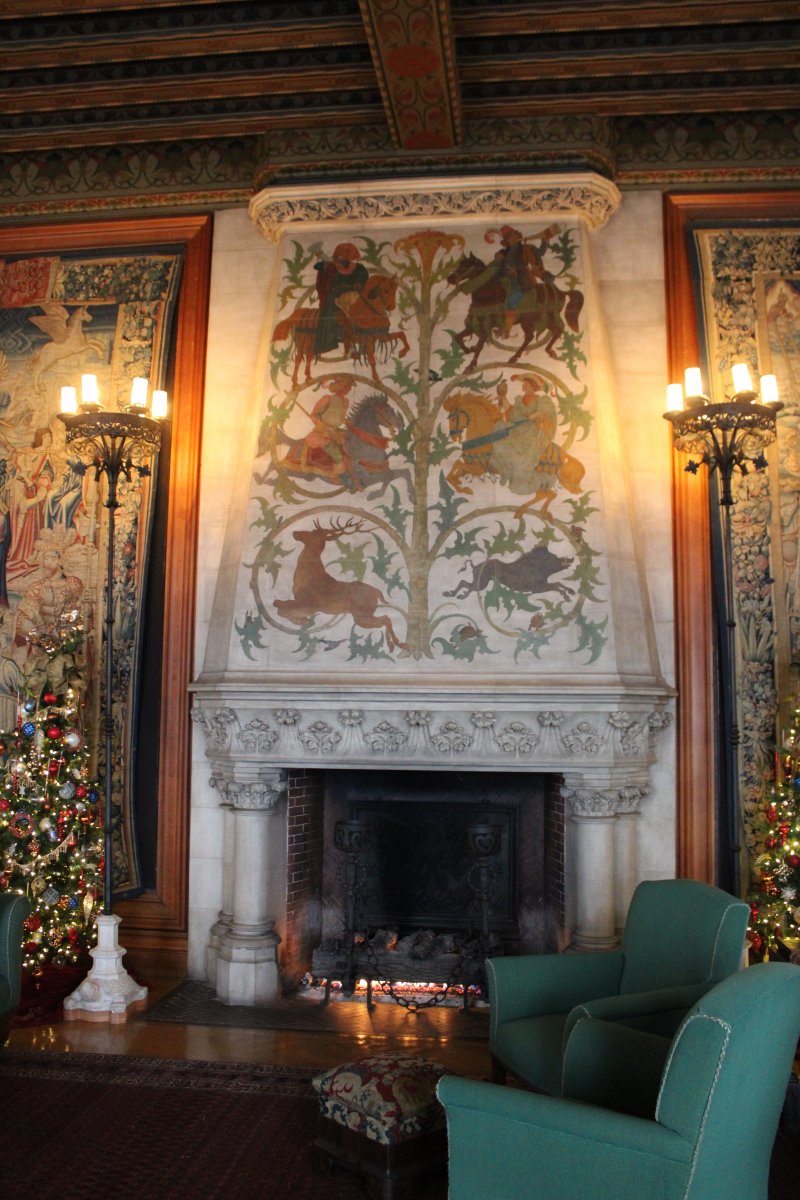 |
|
|
My favorite room in the house: the Library.
Vanderbilt’s book collection consists of approximately 24,000 volumes, with less than half of that in this library. Once termed “one of the best read men in the country” by New York media, George Vanderbilt was a reader from an early age. At age 12, he began keeping a record of the books he had read, including the title and author of each work. The last entry before Vanderbilt’s death in 1914 was No. 3159, the third volume of Henry Adam’s History of the United States. He read an average of 81 books a year. To me, that is amazing. I like to think I read a lot. I also keep a record of the books I have read, although I didn't start record-keeping until I was 32. My average is 32 books a year, mostly non-fiction. My best year ever was 56 books. My total is about 1100. Vanderbilt's total was 3,159 and he died at age 51. So, George Vanderbilt puts me to shame when it comes to reading. Where did he find the time? Of course, they didn't have TV back then, or the Internet.
|
| |
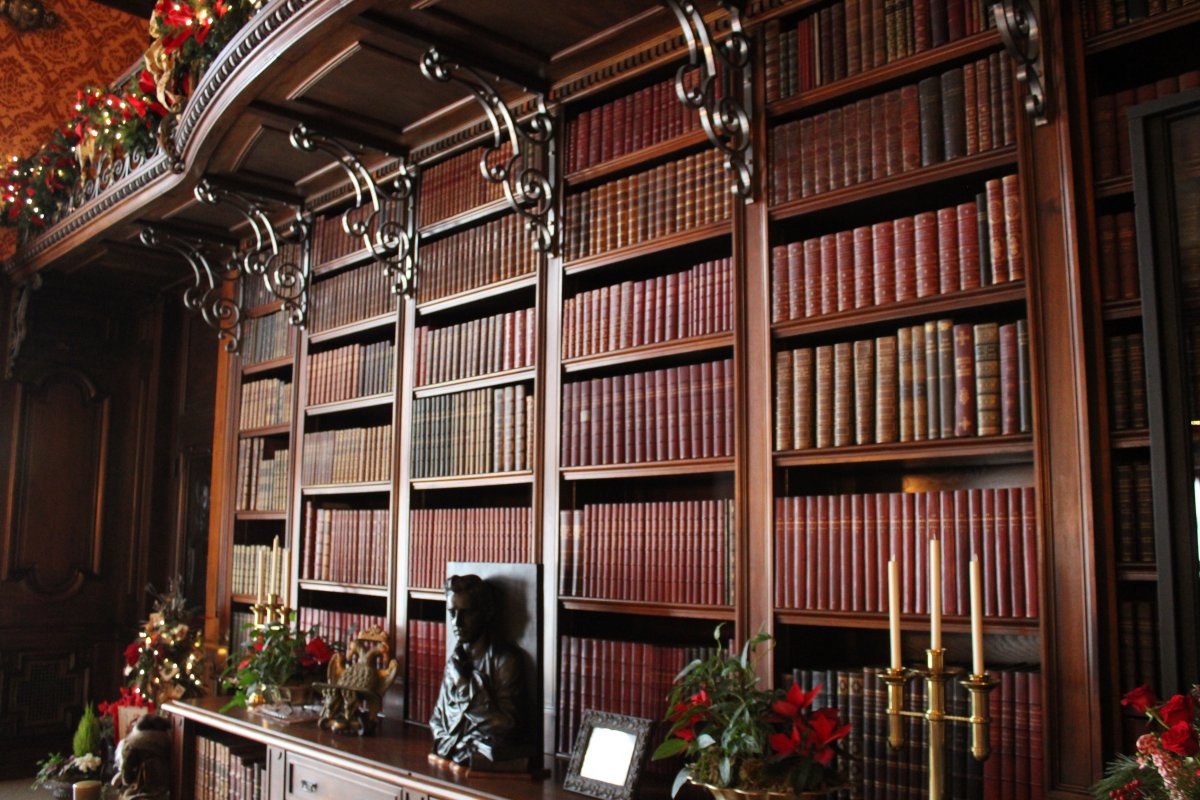 |
|
| |
| |
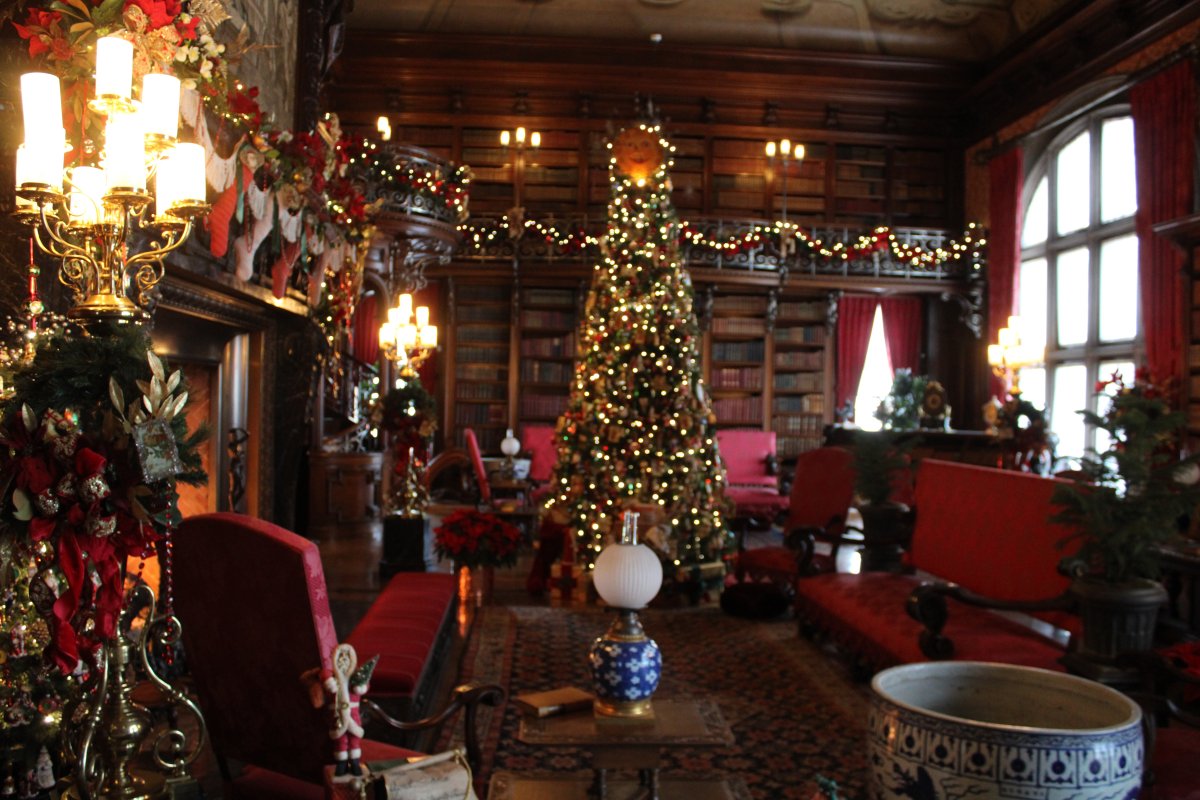 |
|
|
The two-story Library contains over 10,000 volumes in eight languages, reflecting George Vanderbilt's broad interests in classic American and English fiction, world history, religion, philosophy, art, and architecture and gardening. The second-floor balcony is accessed by an ornate walnut spiral staircase. The Baroque detailing of the room is enhanced by the rich walnut paneling.
|
| |
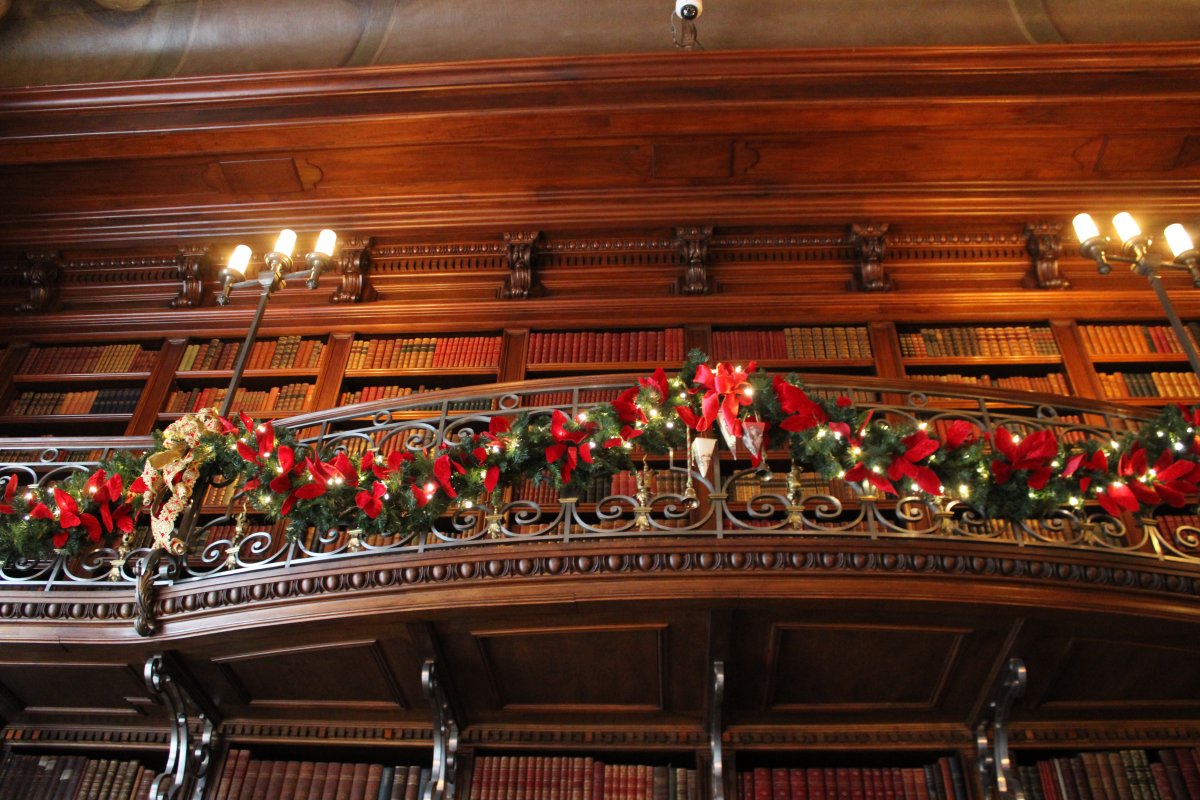 |
|
| The black marble fireplace and walnut mantle were carved by Austrian artist Karl Bitter. |
| |
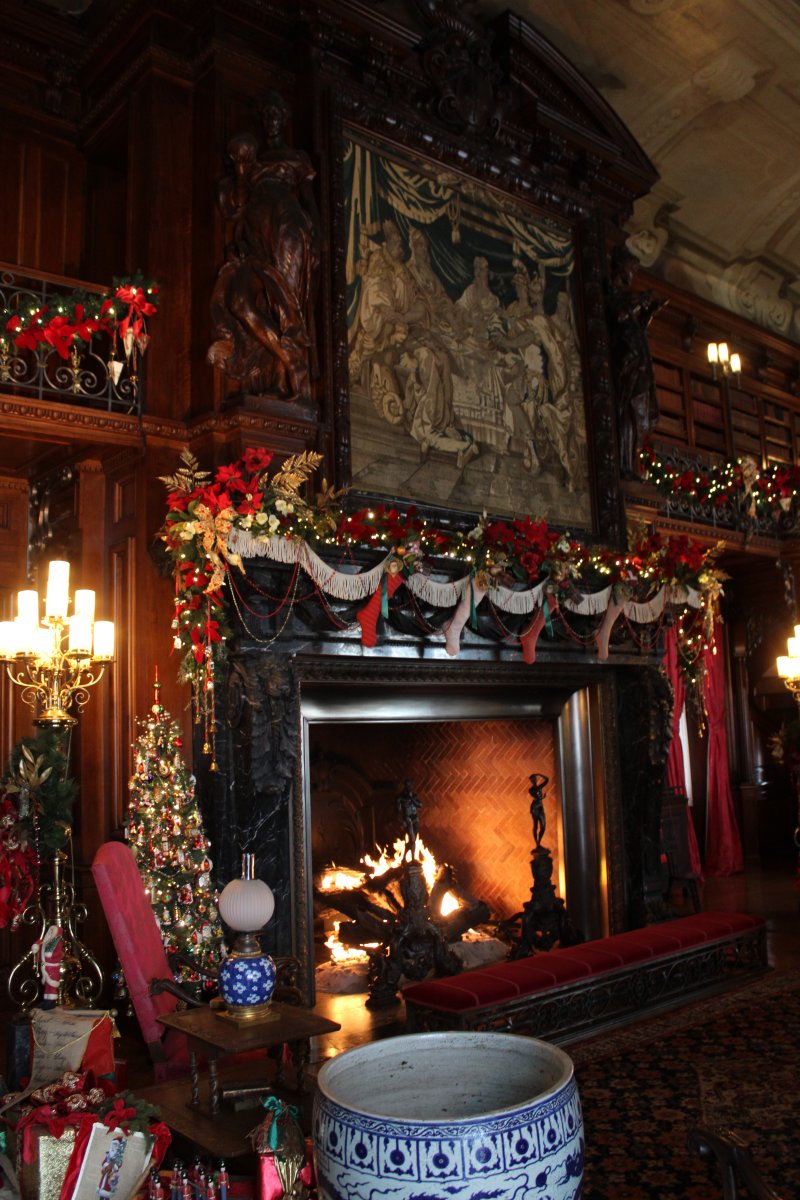 |
|
|
The Library ceiling: just like you would see in a French palace. Actually, an Italian palace. The beautiful painted ceiling is entitled The Chariot of Aurora and was painted by Italian artist Giovanni Pellegrini. It was originally in the Pisani Palace in Venice. George Vanderbilt bought the massive canvas in a sale of the palace’s contents. (The Pisani Palace is now a fancy hotel.). The 18th century ceiling painting is 64 feet long by 32 feet wide, consists of 13 separate canvases, the central scene surrounded by 12 smaller paintings.
|
| |
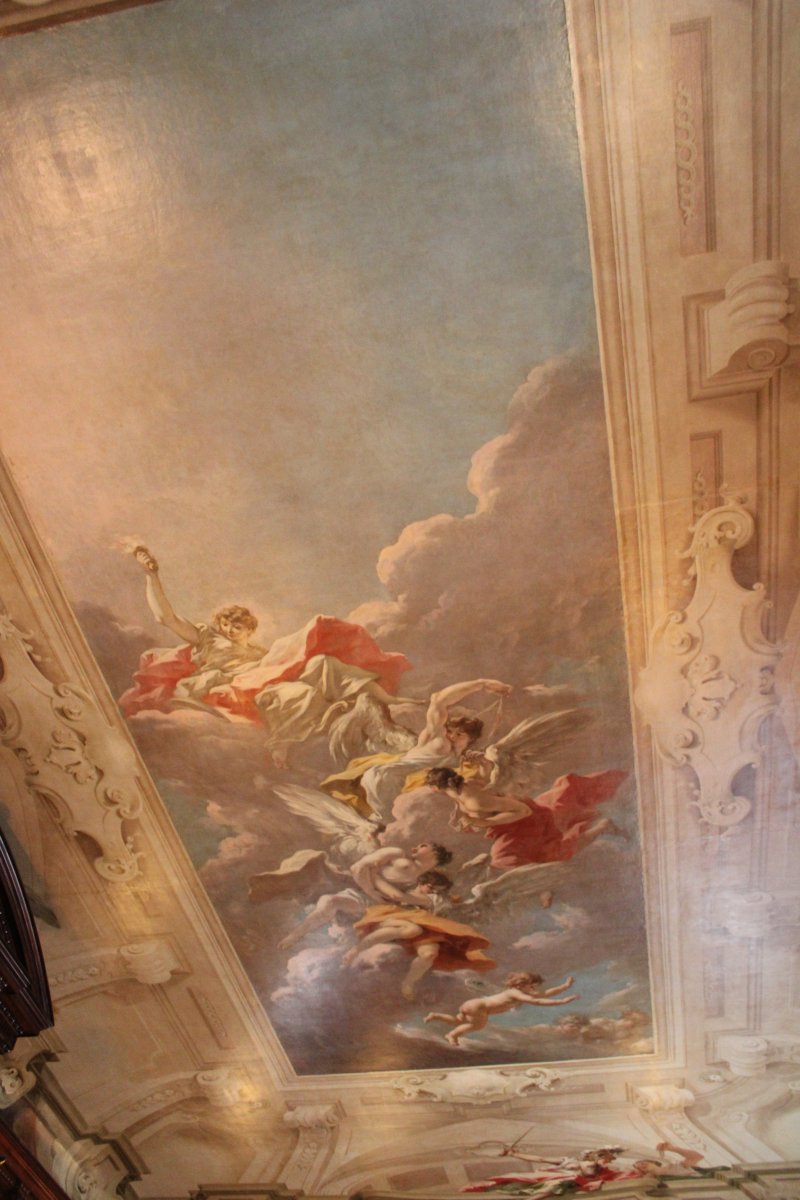 |
|
| A huge world globe in the corner. |
| |
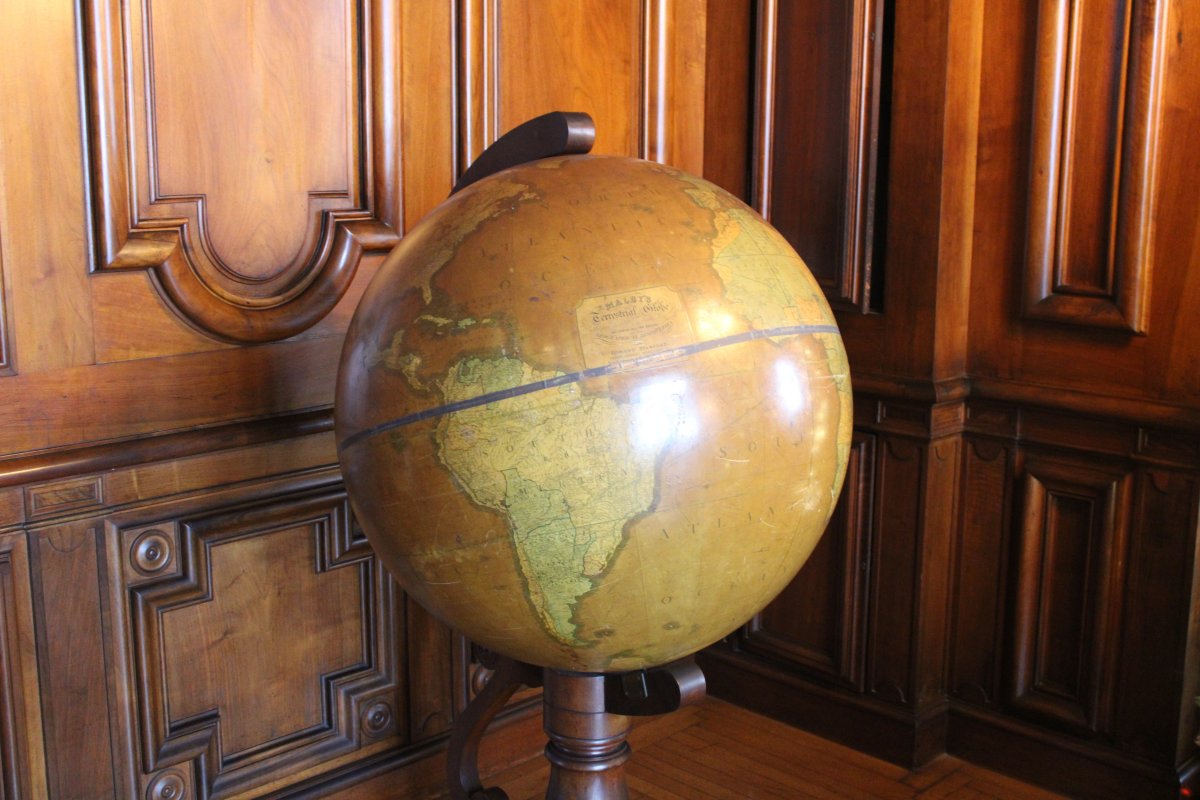 |
|
| The Christmas decorations were beautiful as you can see here in the entrance hall. |
| |
 |
|
| We moved upstairs and came to the Master Bedroom of George Vanderbilt. |
| |
 |
|
|
Not too shabby. Behind those curtains is a great view of the estate.
|
| |
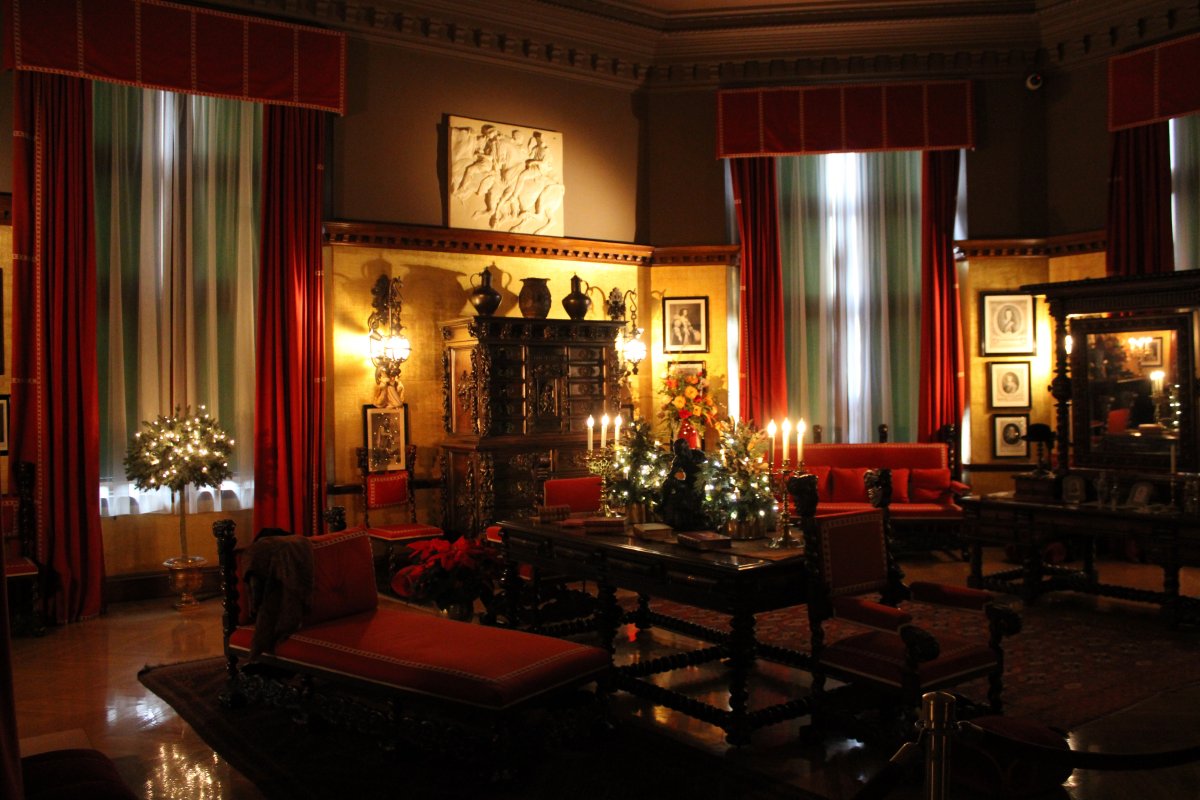 |
|
| The bed may look small, but it's not. It just looks small because of the large room. Notice the copies of the Parthenon frieze on the walls up high. |
| |
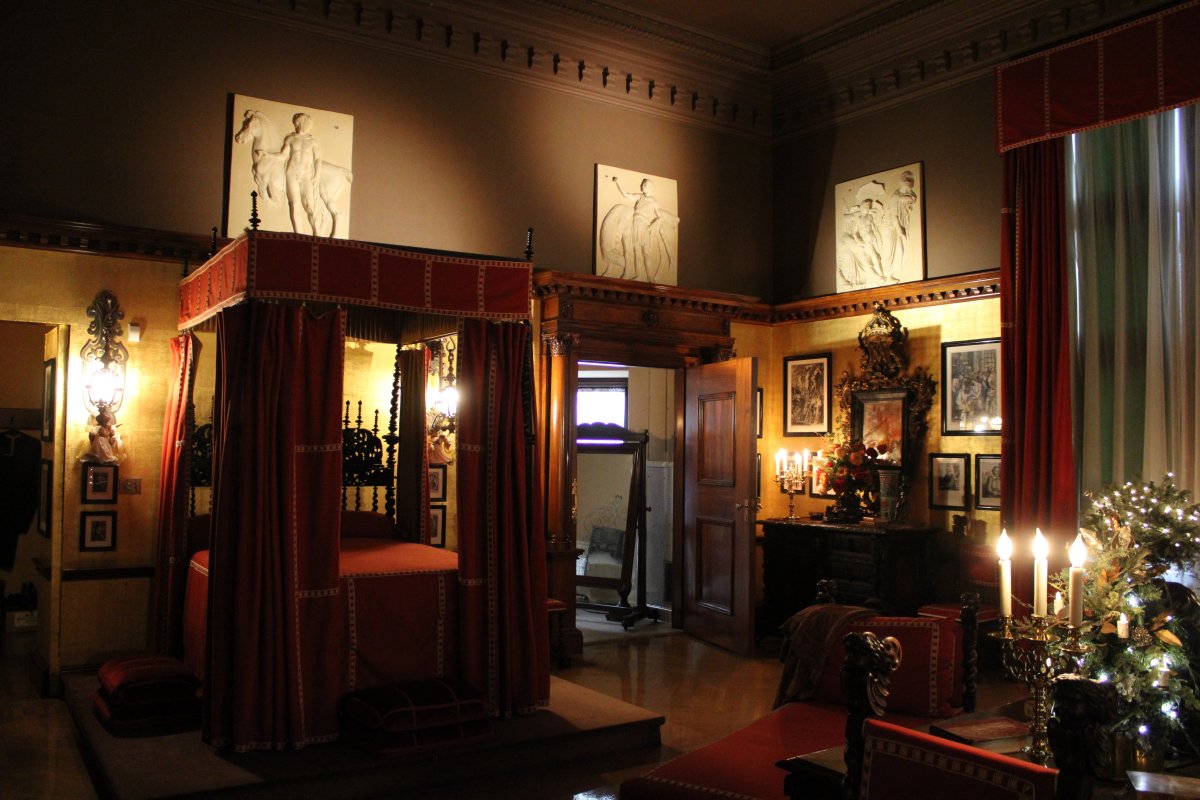 |
|
|
Apparently it was customary in the Gilded Age for husbands and wives to have separate bedrooms for logistical reasons -- whatever that means. The room below is called the Oak Sitting Room and is between George and Edith's bedrooms. This room is where the Vanderbilt's had their breakfast, and Edith planned the day with the head housekeeper. It looks like a comfortable room where husband and wife could just relax together.
|
| |
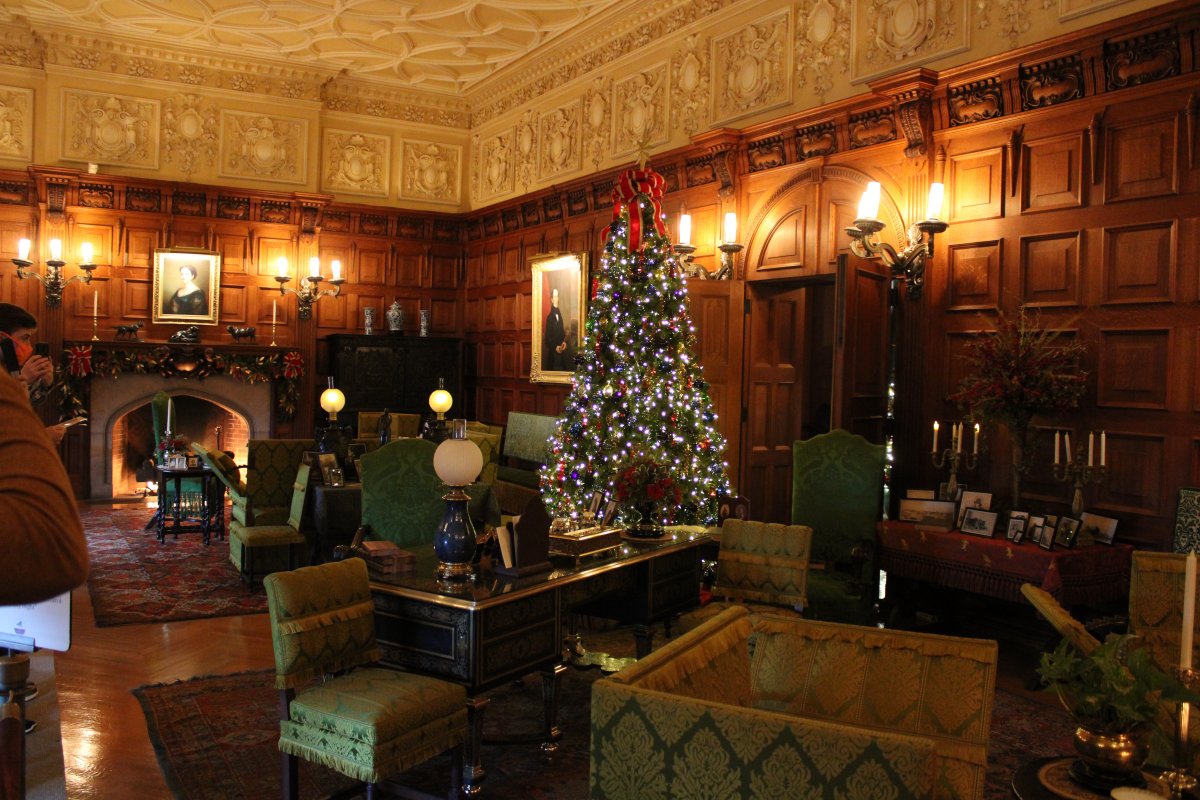 |
|
| George's working desk. |
| |
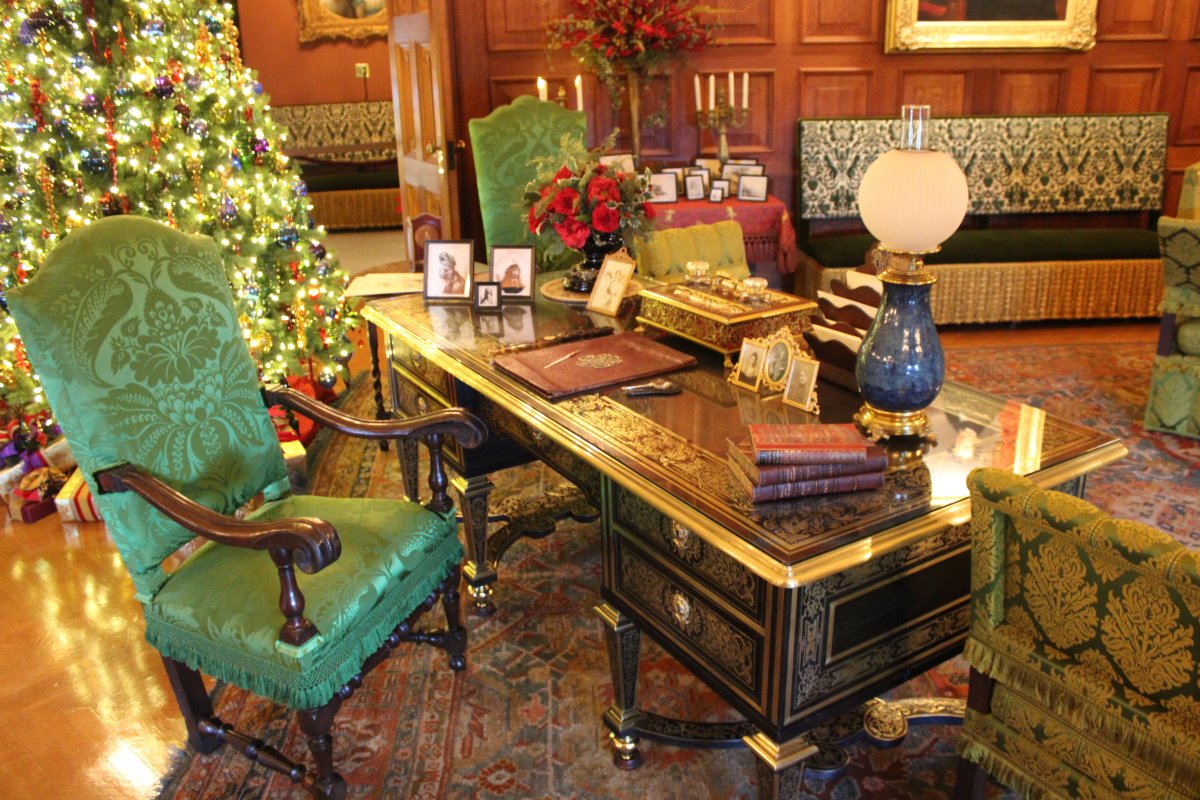 |
|
| A blurry shot of Edith's bedroom. |
| |
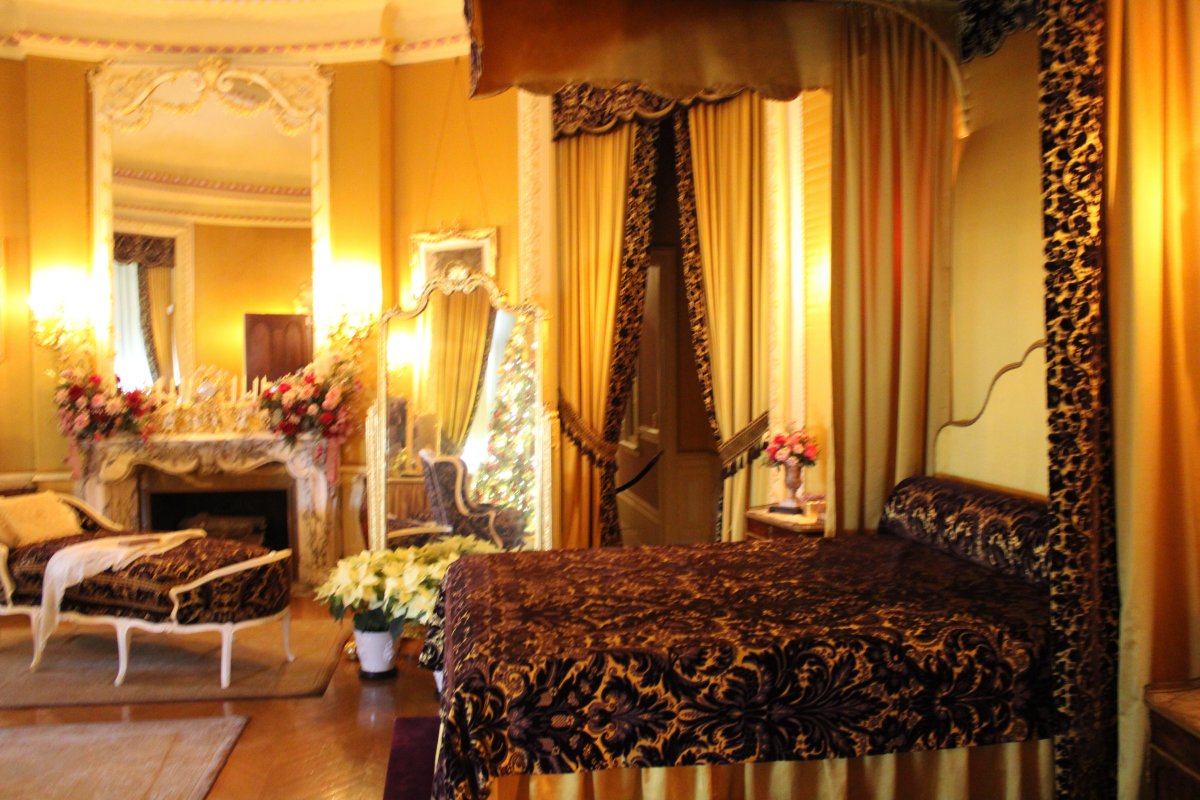 |
|
|
It's not as big as George's but it's still pretty nice.
|
| |
 |
|
| The obligatory Christmas Tree. |
| |
 |
|
| The Smoking Room where male guests ONLY could enjoy after-dinner cigars, pipes, and brandy. |
| |
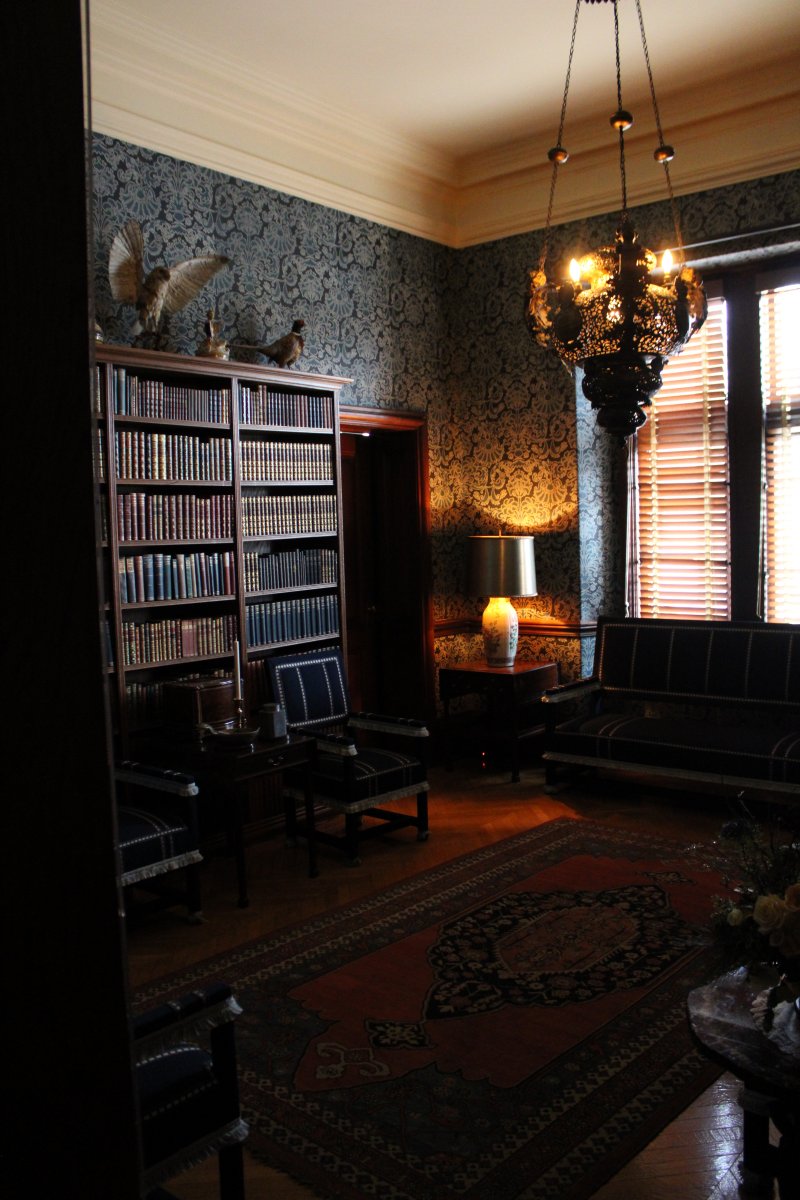 |
|
|
The hunting room. With all the surrounding woods, you can bet hunting was a favorite pasttime of the Vanderbilts.
And this concludes just the first floor of the Biltmore house.
|
| |
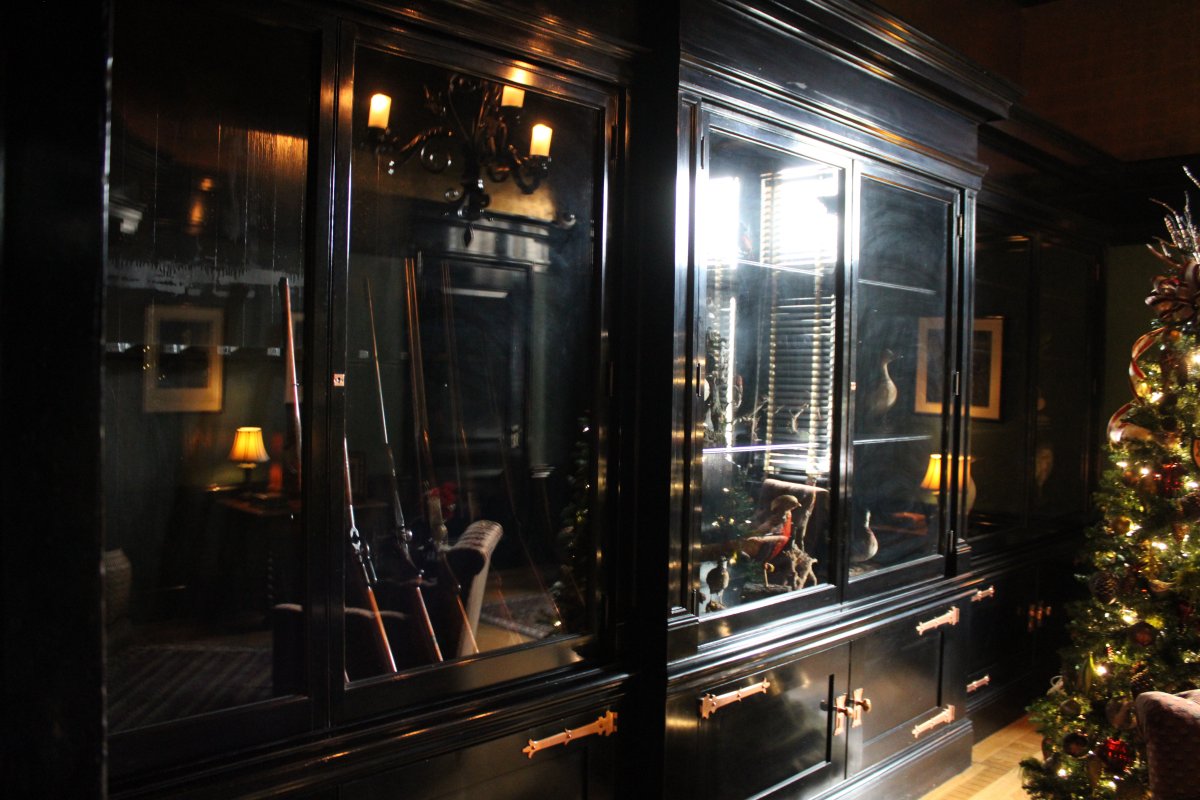 |
|
| |
| |
|
|
|
|
|
|















































